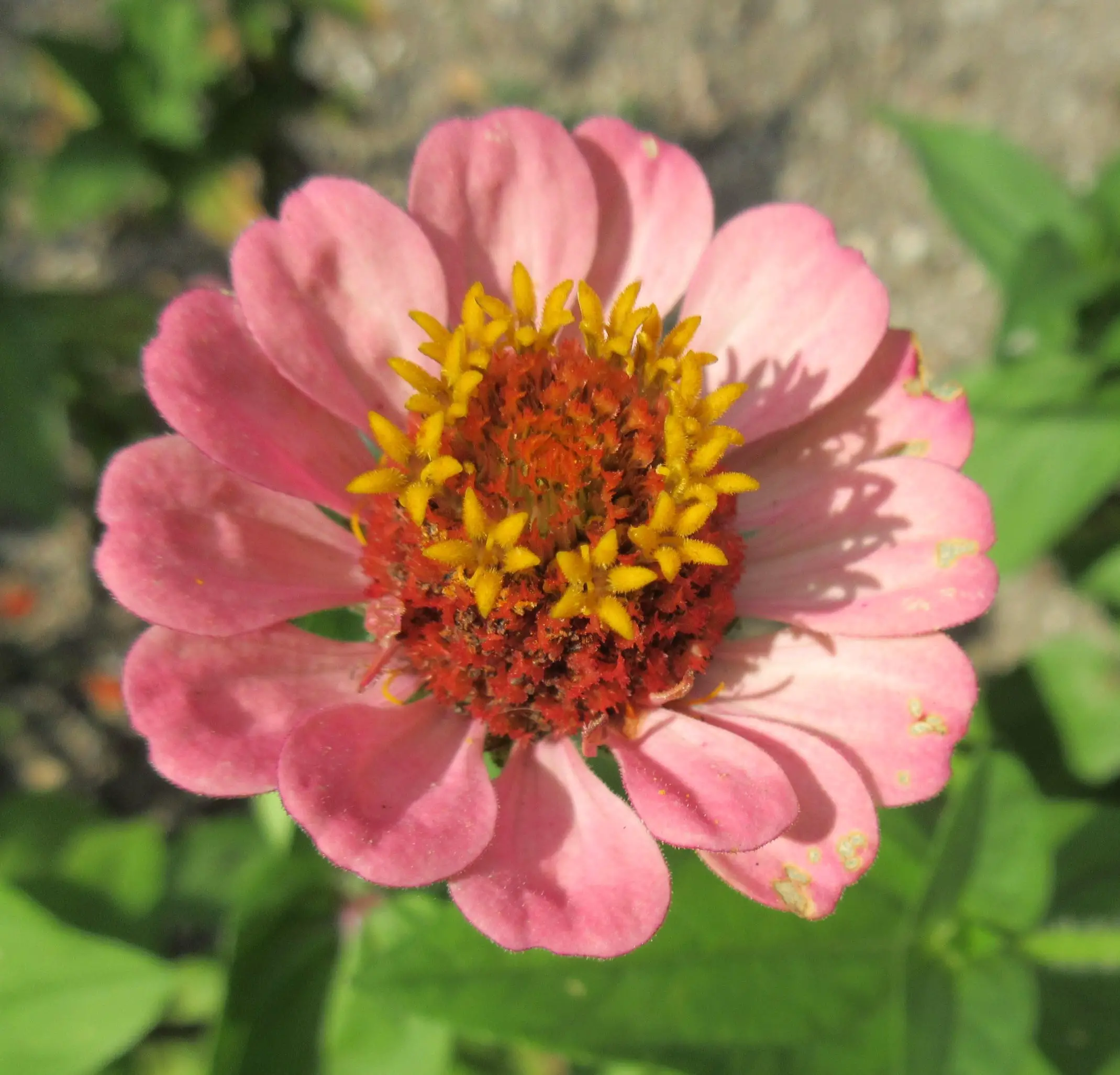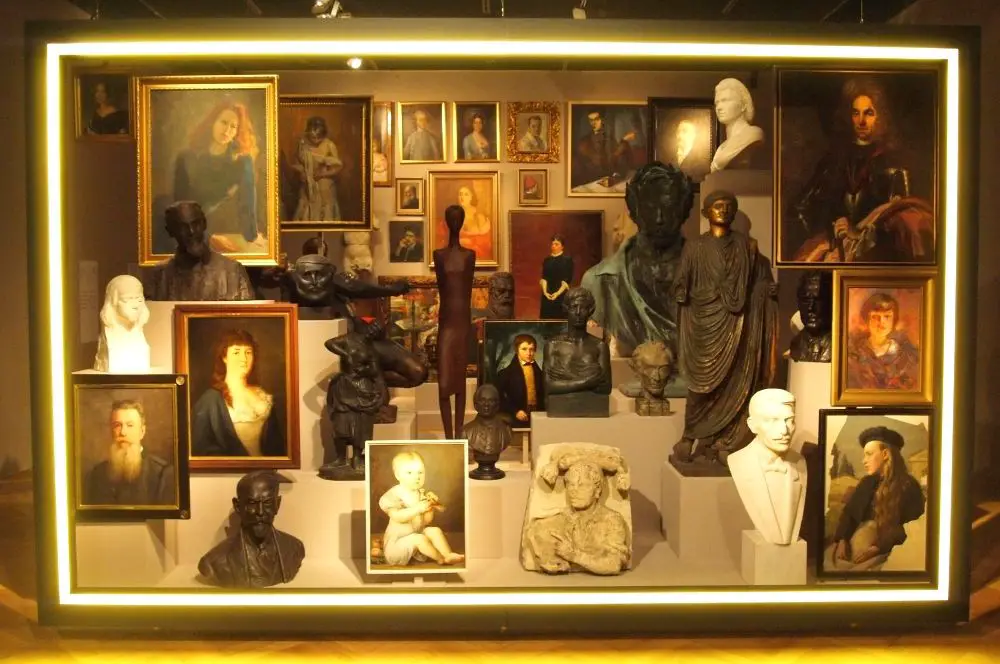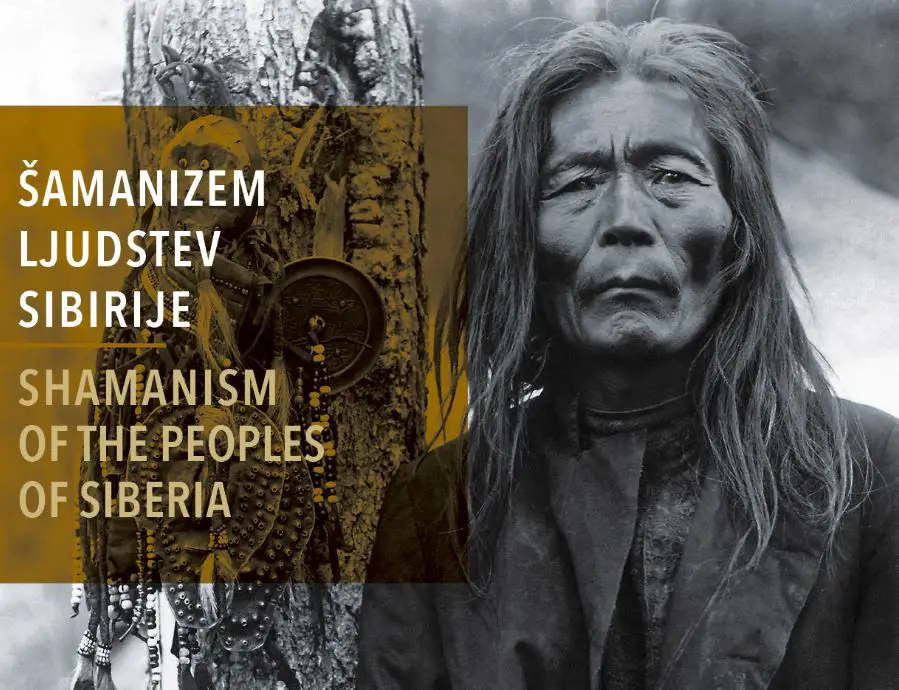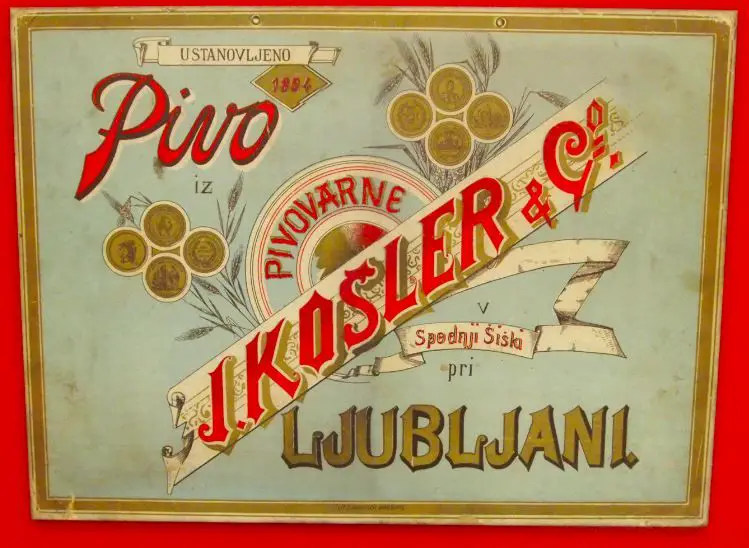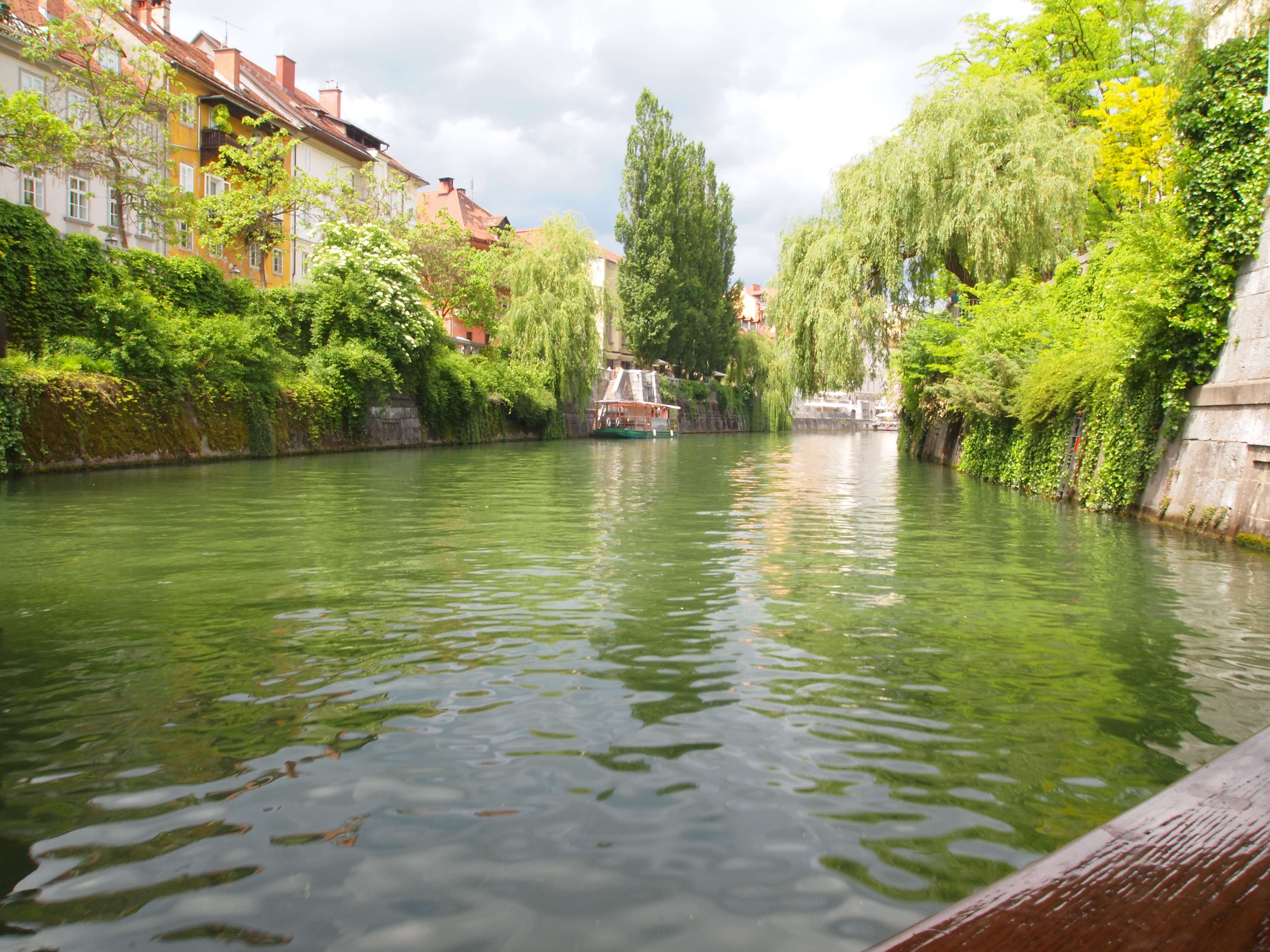Lifestyle
August 14, 2019
With renovation works in Prešeren Square still in progress, not much space has been left for heavy tourist traffic on foot and even less for the most famous or, as some irritated locals would say, infamous musician of Ljubljana centre, the accordionist in the oom-pah Upper Carniolan folk costume, who has until recently entertained the public with his music day and night whether they wanted it or not.
For anyone who misses the man, who otherwise jealously defends his territory and looks away from anyone who wants to take a picture but is not willing to throw a coin into his red accordion case, we found him down at Dragon Bridge today.
We don't know, however, whether he liked his new territory and therefore cannot guarantee whether he is also going to stay.
August 14, 2019
A four-day electronic music festival is about to begin in Ljubljana. Every day from Wednesday to Saturday the programme will begin with a free party at 16:00 in Tivoli Park and then move indoors at about midnight.
While the locations of two outdoor stages will remain in Tivoli Park for the whole four days, the indoor night programme, which will take place between 23:00 and 06:00, will change venues each day. These are Metelkova mesto on Wednesday (Gala hala, Tiffany and Monokel), K4 on Thursday (Kersnikova 4), Božidar on Friday (Viharjeva 11) and Cirkulacija 2 on Saturday (Tržaška 2).
For further details on the programme and tickets, please click here.
STA, 14 August 2019 - A she-bear with a cub attacked a hunter in the woods in the municipality of Ajdovščina, south-west, on Tuesday evening while he approached it unaware of its presence, the Nova Gorica Police Department said in a release on Wednesday.
The police explained the 67-year-old hunter had sat under a tree when he noticed a 150-kilogramme bear with a cub some 10 metres away.
The bear attacked him, biting his leg and scratching his head and body when the hunter started to yell to chase it away.
He sought medical assistance at the local emergency unit on his own, but the injuries were not as severe to require hospitalisation, so he is recovering at home.
The Forest Service, one of the main national organisations in charge of wild animal populations, was notified of the attack to take required measures.
However, analysing the attack it said it was a result of an unlucky coincidence when a hunter ran into a bear with a cub.
And since the incident occurred in the forest rather than near a town, the bear was assessed not to be aggressive so it will be monitored rather than culled.
This was a second bear attack on people this year, said the Forest Service, adding a long-term average is two to three attacks a year.
The first took place at the end of June, when an 80-year-old woman was attacked by a female bear with two cubs near her village some 15 kilometres south of Ljubljana.
Hunters were then ordered to kill the bear and both of its cubs, but could not do it because activists prevented the decree from being implemented.
Once the decree expired, the Forest Service decided not to extend it because there were no other encounters with the bear.
Just two days before this year's first bear attack, parliament passed an emergency bill to reduce the bear and wolf populations by 200 and eleven, respectively.
The law was needed to end the deadlock resulting from the Administrative Court banning bear culling upon an NGO's appeal against a government decree.
This resulted in the bear populations growing rapidly, to some 1,000, whereas the wolf population is estimated at around 80.
But the emergency law has been severely criticised by farmers and hunters, as wolf and bear attacks are continuing.
Hunters have culled 75 bears under the emergency law but not a single wolf since severe restrictions apply to wolf hunting, so they risk high fines.
The rules were somewhat loosened at yesterday's high-profile meeting hosted by the environment minister.
All our stories on bears are here, and those on hunting are here
STA, 13 August 2019 - In the wake of severe criticism by farmers that the emergency law to cull bears and wolves does not bring results, changes facilitating a faster reduction of the wolf population were agreed at a high-profile meeting Environment Minister Simon Zajc hosted at his ministry on Tuesday.
From now on, the Forest Service and the Institute for Nature Conservation will allow that wolves are killed in the entire areas where a pack of wolves lives.
At the moment, wolf culling is limited to the meadows which domestic animals use as pastures, a rule making the culling very hard and has been challenged by hunters.
Zajc explained, speaking to the press after the meeting, the solution was in line with the emergency law, which was passed in June.
A change to the system of emergency culling of wolves was also agreed to allow the Environment Agency to initiate emergency culling whenever a farmer has reported their domestic animals were attacked.
So far, the initiative has had to come from other stakeholders, most often from the Forest Service.
Nevertheless, the Forest Service and the Institute for Nature Conservation will still have to decide whether the culling is justified.
Zajc believes the two biggest obstacles to the emergency law bringing results have been removed.
Under the emergency law, hunters can kill eleven wolves and 175 bears, with the respective populations estimated at around 1,000 and at nearly 90.
Today's meeting came after farmers urged the government at a protest on Saturday to bring the wolf population under control, arguing the new law was ineffective.
The meeting was attended by the representatives of the Forest Service, the Institute for Nature Conservation and the Hunters' Association, among others.
Representatives of the Farmers' Trade Union, who staged the rally on Saturday, did not attend, and Zajc rejected their call for his resignation.
He however announced new meeting for the coming months to come to agreement on how to comprehensively improve the management of wolf and bear populations.
Forest Service data shows that nearly 680 domestic animals, mostly sheep and goats, were attacked by the end of July, double the number from the same period last year.
Earlier in the day, the leader of the opposition People's Party (SLS), Marjan Podobnik, said his party would offer every hunter who kills a wolf in line with the law EUR 500.
He also criticised the rather strict provisions governing the reduction of the wolf population, saying hunters would not hunt in fear of high fines.
Podobnik explained that a wolf could only be killed if it could be proved that it had attacked animals several times.
While the attacks on domestic animals are a problems, the safety of people in rural areas is just as important, he told the press in Ljubljana.
All our stories on wolves are here, while all our stories on hunting are here
STA, 13 August 2019 - Budimir Vuković, one of the thousands of citizens of the former Yugoslavia who were deleted from Slovenia's registry of permanent residents in 1992 (the Erased, Izbrisani), has been granted a temporary residence permit at last, regaining his driving licence as well as a right to work, the newspaper Dnevnik reports.
Vuković has been living in Slovenia since 1978. Being left without permanent residency status following the country's independence, and without citizenship or any documents, he has been unable to leave the country, while living here unlawfully since the erasure.
"Considering that I've been living in Slovenia for 41 years, I'd expect they'd recognise me permanent residence status. But I understand that bureaucracy operates step by step," said Vuković, who used to work as a technician at the Krško Nuclear Power Plant.
He is now earning his living selling Kralj Ulice, the newspaper sold by the homeless people. "I'll be selling the paper until I've found another job," says Vuković, who spends his free time as an author.
Being given back his driving licence, he made his first legal trip abroad on Sunday, driving to Austria for a coffee.
"I can see the light at the end of the tunnel now. I'm well on course to have my status fully resolved," Vuković commented on the ruling giving him temporary status for the paper on Monday.
He was granted temporary residence status by the Administrative Court based on the European Convention of Human Rights and judgements issued by the European Court of Human Rights.
These require countries to tackle the status of people residing in them for a long time regardless of whether they their status had been legalised from the start.
Matevž Krivic, a former constitutional judge who has been acting as counsel for Vuković and other erased, says that this is far from being the only such case.
Gani Redžić, who has been living in Maribor for 52 years, has been granted temporary residence permit only recently based on an appeal to the Constitutional Court.
However, unlike in Vuković's case, the Maribor administrative unit "forgot" to restore Redžić's right to social benefits, the newspaper Dnevnik reports.
STA, 12 August 2019 - Less than half of young women in Slovenia are happy with their current standard of living and many are unhappy at work and ready to move abroad in search of better job opportunities, a survey has found.
The survey, conducted among 500 women in the ages between 20 and 35 as part of a project designed to improve the position of women in the labour market, found that only 35% have a job agreeing with the level and type of their education.
Nine out of ten of those questioned believe that there should be more contacts with potential employers during the education process and seven out of ten say they did not receive any career counselling.
More than a half (57%) would prefer to work in the public sector due to greater job security it offers, while 29% would want to work in the corporate sector and 14% would prefer to work for an NGO.
As many as 44% are unhappy with their current job and only 41% are happy about their pay. Among the unhappy ones, one in three expects their pay to improve and one in five do not expect a rise.
Nefiks, an educational institute which conducted the survey, commented that young women are proactive in seeking work, but still they have it hard to get right jobs.
"Many are willing to work outside their field of education or commute more than 20 kilometres to work, taking jobs below their education. Although 44% of them would prefer much more to work at home, they are even willing to move abroad if they don't get an opportunity," said Nefiks.
Similarly, only 47% of the respondents, including students who are generally happier, are happy with their current standard of living.
The survey also suggests that 44% of young women are not planning a family or do not want it, which Nefiks says is a high proportion, given that the respondents are of childbearing age.
Only 7% say that employment is not an important factor in deciding to have a family.
Women above 30 think they have fewer job opportunities because they are too old to qualify for benefits under the Youth Guarantee scheme, something that the survey confirmed.
This group of women has spent longer finding a job and less than a half of them are happy at their job. Moreover, 70% believe they did not get enough work experience during their school education. They also have housing difficulties.
STA, 12 August 2019 - Slovenian youths are mostly satisfied with their lives, and they are better educated than their parents. But financially, they still feel the effects of the economic crisis and their position on the labour market is much more precarious, show statistics released ahead of International Youth Day.
There were 309,000 persons in Slovenia aged between 15 and 29 at the beginning of the year, more than half of whom were enrolled in education programmes. Just over 161,000 were employed, the Statistics Office says.
A plurality of young women worked in the services sector and in commerce, while young men were most commonly working in construction, maintenance of buildings, metalworking and similar professions.
Despite having work, youths are in a much more precarious position than older employees. As many as 46% had fixed-term contracts, compared to just 16% for the entire working population.
There were 16,000 unemployed persons in the 15-20 age group, which translates into a 9% unemployment rate, or four percentage points higher than the overall unemployment rate.
The average monthly gross wage for this group amounted to almost EUR 1,300 in 2018, or around three-quarters of the average gross wage for all employees in Slovenia last year.
Among the 309,000 persons in Slovenia aged between 15 and 29, only 5% were neither included in formal education programmes nor were they employed. This puts Slovenia among the most successful countries in this respect.
In the 2018/2019 school year, there were 73,000 secondary school students and 67,000 university students. Another 17,000 persons in this age group were enrolled in adult education programmes, which means that more than half of this age group was attending some form of school.
Last year, the share of persons with tertiary education in the 30-34 age group was 42.7%, up from 24.6% in 2005 and from 34.8% in 2010. The share has been constantly above 40% since 2013, the Statistics Office said.
The at-risk-of-poverty rate for this age group was 11.7%, slightly lower than that for the entire population in Slovenia (13.3%).
This age group is the most satisfied in general with their lives, with their average grade on a one-to-ten scale standing at 8.1 in a recent survey, well above the average of 7.3 for the entire population.
The Statistics Office published the data ahead of International Youth Day, marked on 12 August. It is an awareness day designated by the UN in 1999 in to draw attention to cultural and legal issues faced by youths.
While the UN places emphasis on education for this year's International Youth Day, the Slovenian Youth Council (MSS) has pointed to housing. It has also warned about the growing pessimism among the young regarding their prospects of becoming independent.
The organisation has told the STA that there was a lack of public apartments for young people and that market housing was getting increasingly expensive, even as young people cannot get bank loans.
The council is also critical of what it perceives as centralisation of the country, saying that "not all young people want to live in Ljubljana" and that the state encourages migration from rural areas.
Another challenge is the shortage of jobs for highly educated persons, the MSS said, noting that the current generation of young people will be the first after the Second World War whose quality of life is worse than that of their parents.
Tin Kampl, the head of the government Office for Youth agrees that young people today have more problems than the previous generations. He pointed to problems related to employment, housing and getting independent, which is "something out of reach for a majority of young people".
While noting that young people today had more knowledge and experience and more opportunities to participate in society, Kampl highlighted emigration for work or study which he said left a bitter aftertaste if it is necessity-driven.
According to a survey by the Nefiks institute for the promotion of informal education, as many as 44% of women in Slovenia aged between 20 and 35 sees going abroad as a solution if they fail to get a job in their own country.
The survey has found that only 47% of young women are satisfied with their current standard of living, while 44% are satisfied with their current job. Nefiks has noted that young women in Slovenia are proactive and flexible in job seeking.
With employment of young women connected with family planning, the survey has also shown that 44% of young women who participated in it do not plan a family or do not want to have a family. "Considering that the survey covers women in their fertile age, this is a high percentage," Nefiks said.
All our stories on demographics in Slovenia are here
STA, 12 August 2019 - A central ceremony marking Eid al-Adha or the Festival of the Sacrifice, one of the biggest religious holidays in Islam, was held in Ljubljana's Kodeljevo Arena on Sunday. The ceremony was addressed by Mufti Nedžad Grabus, with the start of prayers scheduled for 6.36am.
The Muslim holiday provides an opportunity for believers to embark on a self-reflection journey and consider righting the wrongs they might have done to themselves or others, said the Muslim community in Slovenia.
The believers should be aware how unpredictable and ephemeral life is, given that everything is transient, it added.
The Festival of the Sacrifice is the time for atonement and asking for forgiveness, but also the time for sharing joy with loved ones.
The Eid al-Adha celebrations start with pilgrims setting out on trips to Mecca and Medina.
The highlight of the annual pilgrimage, which took place on Saturday, is held on Mount Arafat, a hill east of Mecca in the plain of Arafat, where pilgrims gather to pray in unity which defies any class, political or social divides.
This year, 28 Muslims from Slovenia have embarked on the journey to Mecca. Those who are not part of the pilgrimage celebrate the holiday with their families.
Apart from Ljubljana, Eid al-Adha prayers will be held in other Slovenian cities and towns with Muslim communities as well.
Next year's Eid al-Adha celebrations are expected to take place in the Ljubljana mosque instead of the Kodeljevo sports arena since the construction of the former is all but completed.
All our stories on Islam in Slovenia are here
Keep up with the daily news in Slovenia by checking the morning headlines here
This schedule was prepared by the STA
MONDAY, 12 August
NOVO MESTO - Jazz festival Jazzinty will get under way with a performance by Gašper Livko and Tisa Neža Herlec.
TUESDAY, 13 August
LJUBLJANA - The signing of an agreement between several Slovenian and Japanese institutions on cooperation in the development of medical robotics.
LJUBLJANA - Administered fuel prices will change.
GORNJA RADGONA - The 57th international agricultural and food fair AGRA 2019, scheduled for 24-25 August, will be presented to the press.
TRONDHEIM, Norway - Slovenian football champions Maribor will take on Rosenborg in the return leg of the third round of qualifying for the UEFA Champions League.
WEDNESDAY, 14 August
LJUBLJANA - Japan's Foreign Minister Taro Kono will visit Slovenia. Meetings with Foreign Minister Miro Cerar and President Borut Pahor are scheduled.
LJUBLJANA - The Statistics Office will release June construction data.
THURSDAY, 15 August
LJUBLJANA - Assumption of the Virgin Mary, a public holiday.
TOLMIN - The start of Overjam, a reggae festival; until 18 August.
FRIDAY, 16 August
LJUBLJANA - The Statistics Office will release June pay data.
BREŽICE - Seviqc, a festival of old music, will get under way with a concert by Simone Vallerotonda playing 17th century lute and guitar music.
SATURDAY, 17 August
BELTINCI - A state celebration of the 100th anniversary of unification of Prekmurje region with Slovenia. Prime Minister Marjan Šarec will deliver the keynote.
SUNDAY, 18 August
PORTOROŽ - The final matches will wrap up at the ATP challenger tennis tournament Slovenia Open 2019.
If you're not in town for the week of this guide (12 - 18 August, 2019) then you can see all the editions here, and if there's event or activity you want to promote in a future edition of What's on in Ljubljana please get in touch with me at flanner(at)total-slovenia-news.com or try and find me on Facebook.
In town and want to follow the news? Check out our regular morning headlines for Slovenia here.
As ever, links to the basic listings are after the following selection, while a comprehensive PDF of events for the next seven days, as prepared by Ljubljana Tourism, is here.
It’s hot and the streets are often packed. Getting a table by the river’s a lucky find and much less Slovenian is heard. It’s when locals who can leave do, and if they have a place to rent out then it goes up online, which then pays for a vacation in Ibiza.
This week, weather permitting, the streets will be alive with people and performers. Some of the many and varied entertainments that you might not stumble across are laid in the listings below,
Don’t worry if you don’t see everything you “should”, because some of the best sights in Ljubljana are those you can only get by sitting outside a café, or in a park, and watching the world go by.
That said, if you're in town you really should visit Ljubljana Market - it's small, varied and offers fresh fruit, vegetables, local specialities, snacks and souvenirs, while being next to many other sights. Learn more about it here.
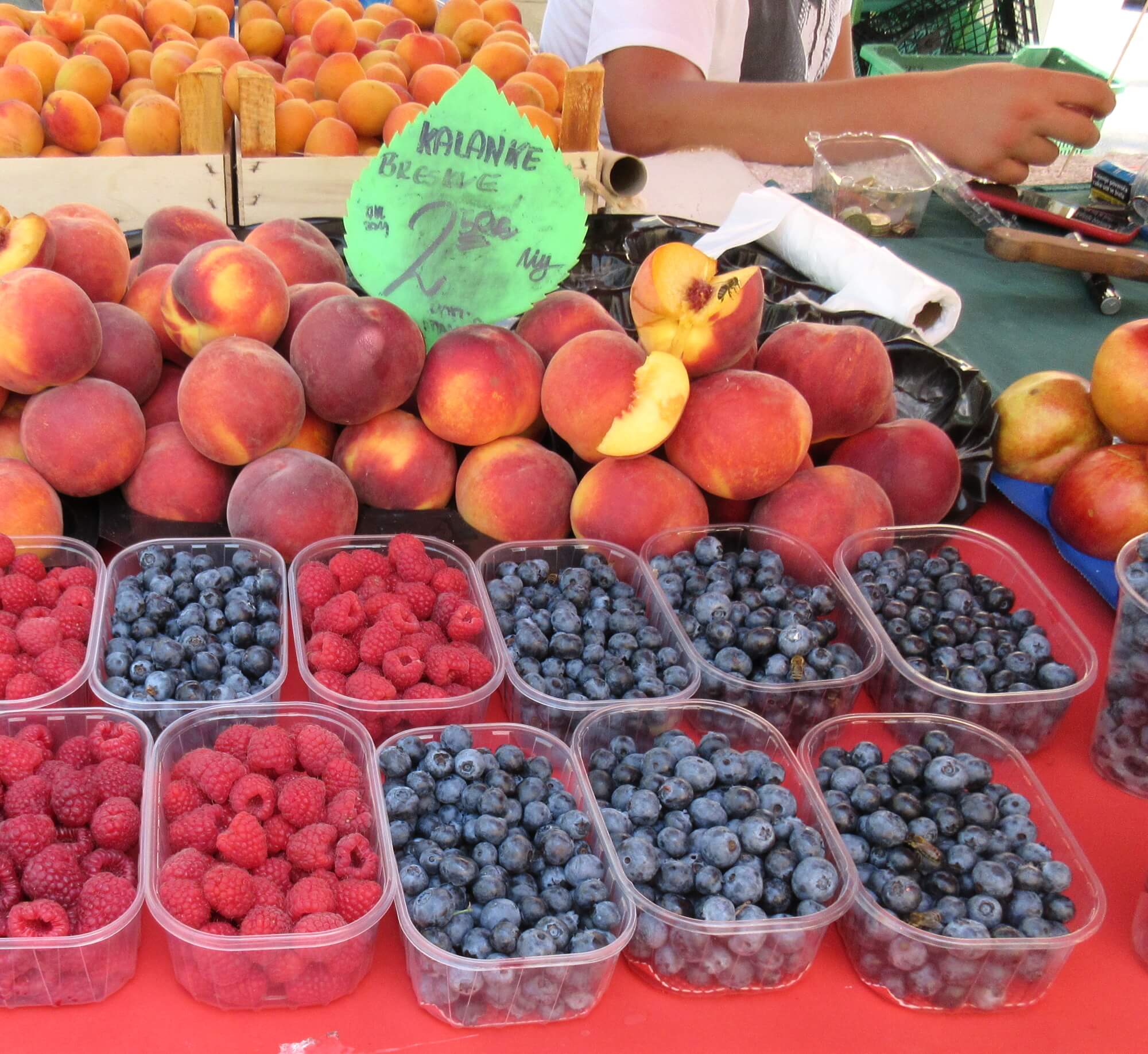
Photo: JL Flanner
Take things slow, rest often, and explore – Ljubljana’s got everything you need.
Tuesday, 13 August, 20:00 at the National Gallery you can see and hear The Kodály Quartet, together for more than five decades, it’s one of the world’s leading chamber ensembles. Wednesday, 20:00, Kino Šiška will have a concert by Kikagaku Moyo, a neopsych band from Japan touring on the back of last year’s Masana Temples album. Wednesday, 20:00, there’s also more classical in the National Gallery with the Goffriller Ensemble.
Fans of electronic music and dancing are in for a treat, with the 4-day od:vod festival running from Wednesday until 06:00 Sunday. Every day from Wednesday to Saturday the DJ programme will begin at 16:00 in Tivoli Park and then move indoors at about midnight, visiting Metelkova mesto on Wednesday (Gala hala, Tiffany and Monokel), K4 on Thursday (Kersnikova 4), Božidar on Friday (Viharjeva 11) and Cirkulacija 2 on Saturday (Tržaška 2). More details here.
Friday to Sunday Kongresni trg will host the Ljubljana Challenger 3x3 tournament, with 16 top street basketball teams from all around the world competing for inclusion in the FIBA 3x3 World Tour masters tournament.
TrNOVfest is back for the whole month of August, with theatre and dance workshops, art exhibitions, Indian dances, literary and film evenings, stand-up comedy, graffiti workshops, DJ sessions and more, with food and craft beer to go along with music that ranges from jazz and acoustic to rock, metal, and trap. Tickets at €5, things happen at the Centre of Slavic Cultures France Prešeren, and details are here.
The Ljubljana Festival, which continues until 5 September and has a packed programme of world-class concert, opera, and ballet events – see more here. This Thursday you can hear Schubert, Schumann and Strauss being played by Alena Baeva on the violin and Vadim Kolodenko at the piano at the National Gallery; while on Friday Križanke will host Il Terzo Suono, a baroque ensemble playing Vivaldi, Tartini and Telemann on period instruments.
The Summer in Ljubljana Old Town goes on until 28 August. This presents classical concerts, many of which are free, in the churches, inner courtyards and squares in the old city centre. The programme is here. Running until 1 September is the Mini Theatre’s season for children and young people, with details here.
Volčji Potok Arboretum (Volčji Potok 3) has a rose garden in bloom until 31 August, nature permitting.
I took a trip to the Botanical Garden two week's ago, a short or cycle upriver from the centre. I know nothing about plants but I like them, took a camera and had a good time. All the outside part is free to enter, and there’s a small café with ice cream, coffee and beer.
JL Flanner
If you're learning Slovenian then you can find all our dual texts here
While the Old Town is quaint, and full of music, where does Ljubljana really shop? One popular answer is BTC City, a vast complex of malls, entertainment facilities and more, including more than 70 different food vendors, offering everything from Slovenian to Thai, Indian to Italian, Mexican to Chinese. Check out my recent visit here.
Looking for something different to eat? Trubajeva cesta, running right by Dragon Bridge, has the greatest concentration of "ethnic food" places in Ljubljana, and thus perhaps the country. Check out our walk through guide as of June 2019.
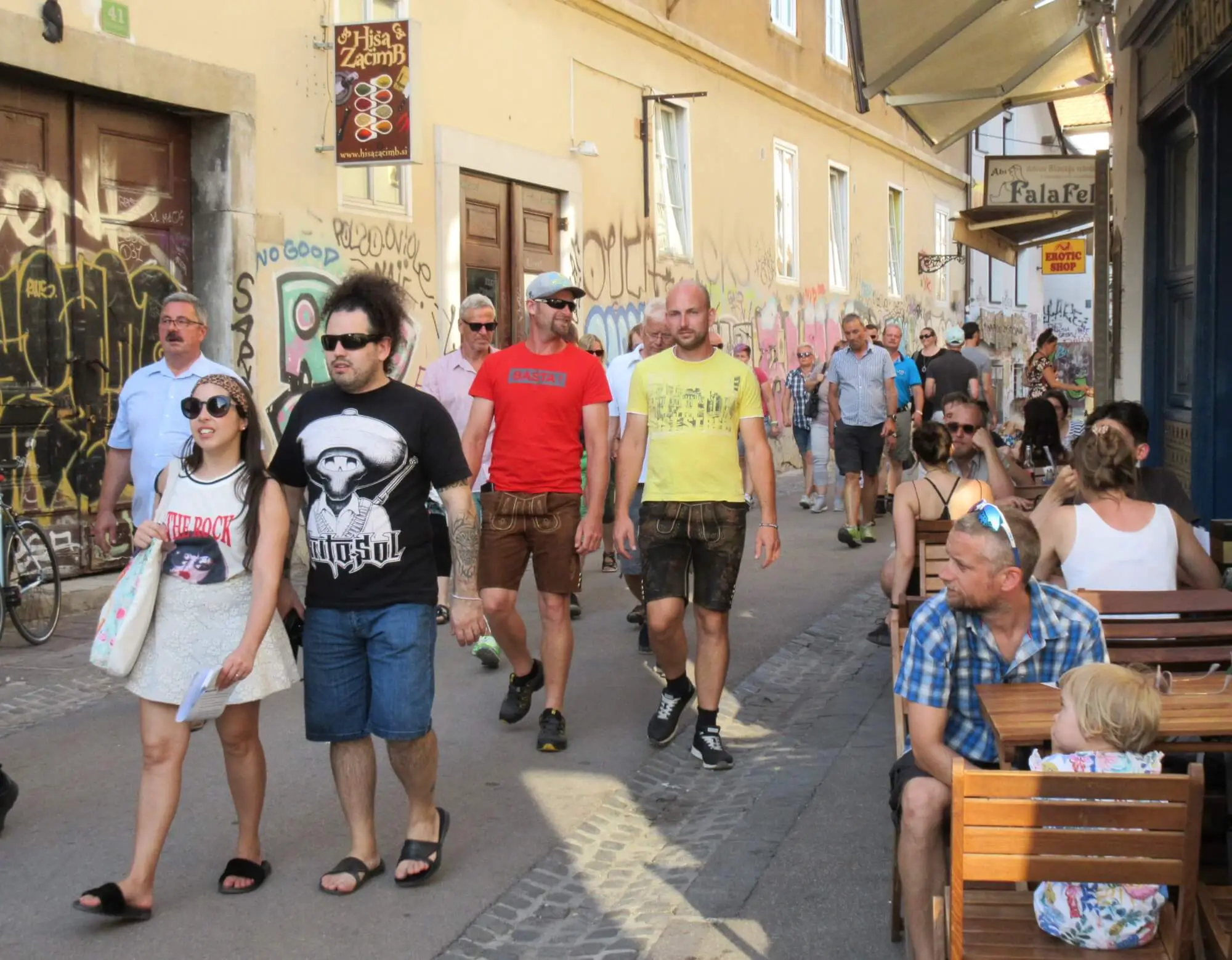
Photo: JL Flanner
Ljubljana is forecast to be the fastest-warming city in the world over the next few decades.
- Cinemas and films
- Clubbing
- Live music
- Theatre and dance
- Harm reduction and drug testing
- Things to do with children
- LGBT+ Ljubljana
- Ljubljana Castle
- Museums and galleries
- Other things to do in Ljubljana
- Daytrips
- Getting around
- Emergencies
Cinemas and films
You can read about all the cinemas in town here, while a selection of what’s playing this week is below, and note that kids' movies tend to be shown in dubbed versions, while non-English language movies for older viewers will have Slovenian subtitles.Parents should also pay attention to Kinobalon, which is Kinodvor's regular weekend series of film screenings and events for children, from babies on up, with special parent/child events, "first time in a cinema" screenings, and babysitting. Learn more about it here, and see the current schedule here.
Note - most children's films will be dubbed (sinhronizirano) - for subtitles look for 'podnapisi'
Film Under the Stars gives you the chance to watch some of the leading art films of the past year outside at Ljubljana Castle, each night at 21:30. The full schedule and trailers are here.
Kinodvor –This is an arts cinema, not far from the train station, that shows new features as well as hosting the occassional festival.
Kinoteka – And not far from Kinodvor you can find this revival cinema, which shows art house classics along with some deep dives in the archives.
Kino Bežigrad - A relatively small theatre, but one which usually has the biggest of the new releases.
Kolosej -The multiplex out at BTC City Mall shows all the big movies, with well over a dozen titles on the schedule, although note that there are far more movies than screens, so some of the older ones mayonly be playing once or twice a week.
Komuna – The cinema in a basement behind Nama department store shows two or three different features a week, usually including the biggest titles.
Looking for a souvenir you'll really enjoy? Take a look at Broken Bones Gin, the first gin made in Ljubljana (learn more here, and try it at the Central Market or selected downtown bars).
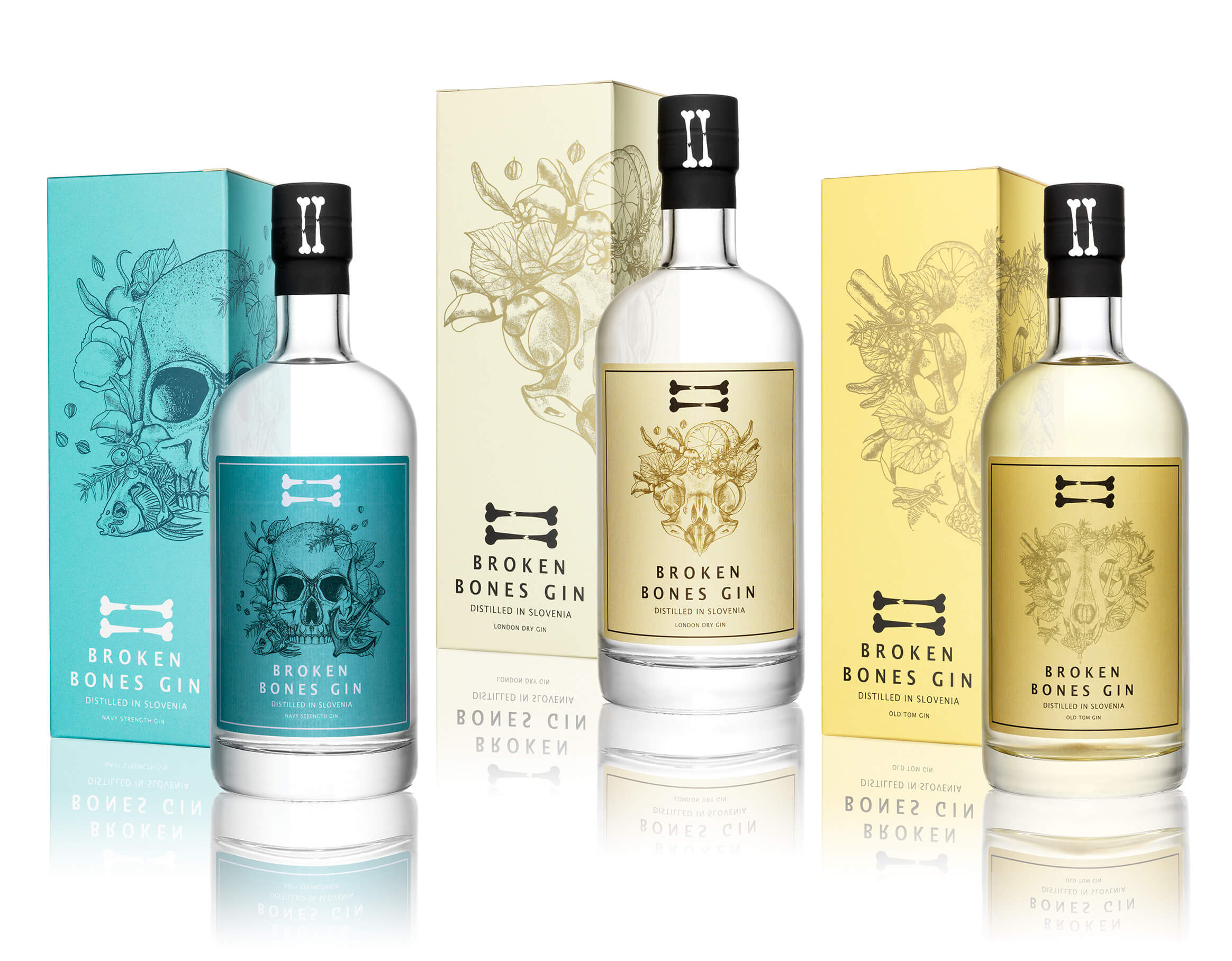
Clubbing
Compared to some European capitals it can seem that nightlife in Ljubljana ends rather early, especially along the river, but there are still bars that stay open late and clubs were you can dance until dawn, and perhaps the best place to stumble across something interesting is the legendary Metelkova. Be aware it's a grungy kind of place and not for all tastes, but also that there's considerable variety to found within the various clubs there, from death metal to electropop, gay cabaret to art noise. You can read "the rules" of the place here. And if you're curious about how the place started then read our story, and look at some pictures, about last year's 25th anniversary.
Božidar - DJ events aren't too common here, but when they happen they often have a big name.
Channel Zero – DJs shows here include regular dub nights as well as electronic music.
Gala Hala – Another Metelkova venue, you can sometimes hear bhangra and Bollywood here, but more often funk, hip hop, breakbeat and so on.
Klub Cirkus – The more commercial end of clubland, and a venue that aims to serve the student party scene. Expect house, anthems, and bangers.
Klub K4 – The home of techno, old and new, along with various other electronic genres,
Koncertna Dvorana Rog– There are irregular DJ sets at this underground (not literally) venue at the far end of Trubarjeva cesta, and they range from techno to goa to drum'n'bass.
Orto Bar– 80s and 90s throwback nights can often be found here, along with rock-based DJ sets.
Live music
Balassi Institute – Free Hungarian music, when available, from the Hungarian cultural institute just a short walk downriver from Dragon Bridge.
Cankerjev dom – The main arts venue in the country hosts classical, opera jazz, folk and occassinally pop.
Cvetličarna – Regional pop and rock concerts can be found here.
Channel Zero – This Metelkova venue sees live shows from punk and rock bands, as well as others.
Gala Hala – Another Metelkova venue with indie bands of various styles.
Kino Šiška – One of the top live venues in the city, with a varied programme that include indie, rock, pop, experimental, hip hop, and so on.
Klub Gromka – Live music is often metal, from sludge to stoner, death to thrash, while punk bands also appear, as do others.
Križanke – The venue that hosts the Ljubljana Festival often has classical music, and some rock, in the open air.
Ljubljana Castle – Jazz, funk and pop every Friday night.
Orto Bar– The home of live rock, metal, punk and other guitar-based genres.
Pinelina dnevna soba – LIve music is rare here, but it does happen.
Slovenska filharmonija– Classical music in the centre of town.
SNG Opera and Ballet - As the name suggests, here you'll find the best of opera and ballet in the country.
Španski borci - While dance is more common here, they also have some contemporary and experimental music shows.
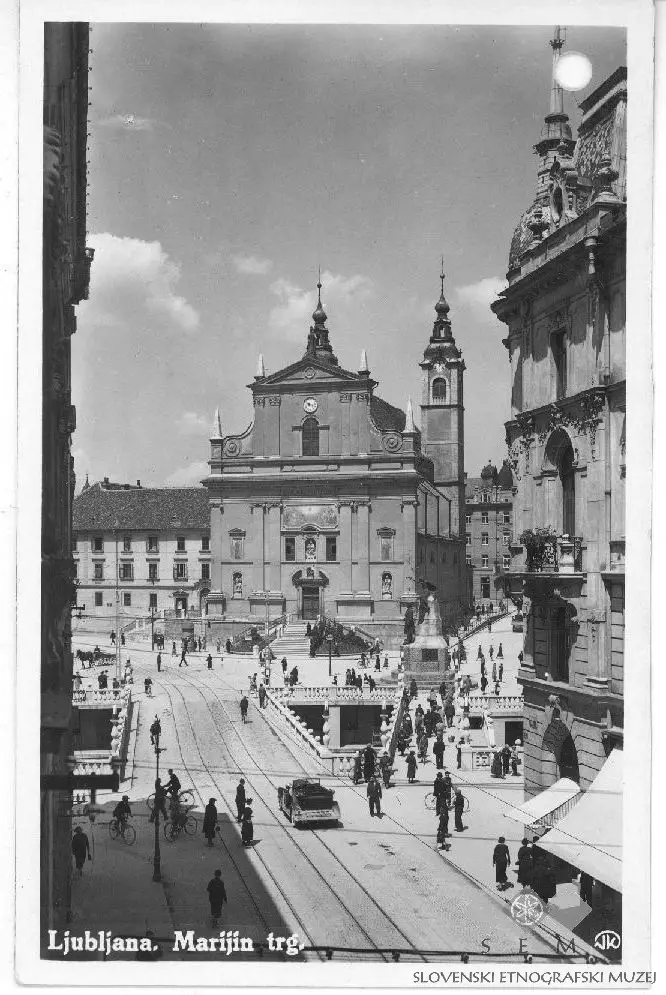
See more pictures of Old Ljubljana here
Theatre and dance
Cankerjev dom- The main arts venue in the country always has something of interest going on.
Gledališče IGLU - IGLU Theatre – Saturday night this group is usually putting on an English improv show somewhere in town, but it’s generally promoted after this is written, so check the Facebook before putting on your shoes.
Kino Šiška – One of the top live venues in the city also hosts some dance performance, often of the more experimental variety.
Mini Teater Ljubljana –The English schedule of varied performances, for adults and children, for the month is here.
Ljubljana Puppet Theatre - Puppetry has a long and noble tradition in Slovenia, and you can see performances for children and adults (including non-puppet shows) drawing from the Theatre's rich repetoire as well as new productons.
SNG Opera and Ballet - As the name suggests, here you'll find the best of opera and ballet in the country.
Španski borci - The home ofcontemporary dance(and the EnKnapGroup) in Slovenia.
Pocket Teater Studio– There are regular flamenco evenings at perhaps the smallest venue town, but note that the number of seats is very limited, and thus you should make a reservation via This email address is being protected from spambots. You need JavaScript enabled to view it. or 070 325 522.
Harm reduction and drug testing
Drogart is an organization that aims to minimise harm on the party scene, and offers drug-testing services and reports on their webpage. It’s in Slovene, but you can Google translate it or work things out yourself, and our story on the group is here.You can find the latest warnings on fake drugs and high strength pills and powders (in Slovene) here. However, be aware that all the usual drugs are illegal in Slovenia.CBD is legal, though, and our retailer of choice can be found on Trubarjeva cesta - read more about Sena Flora here.
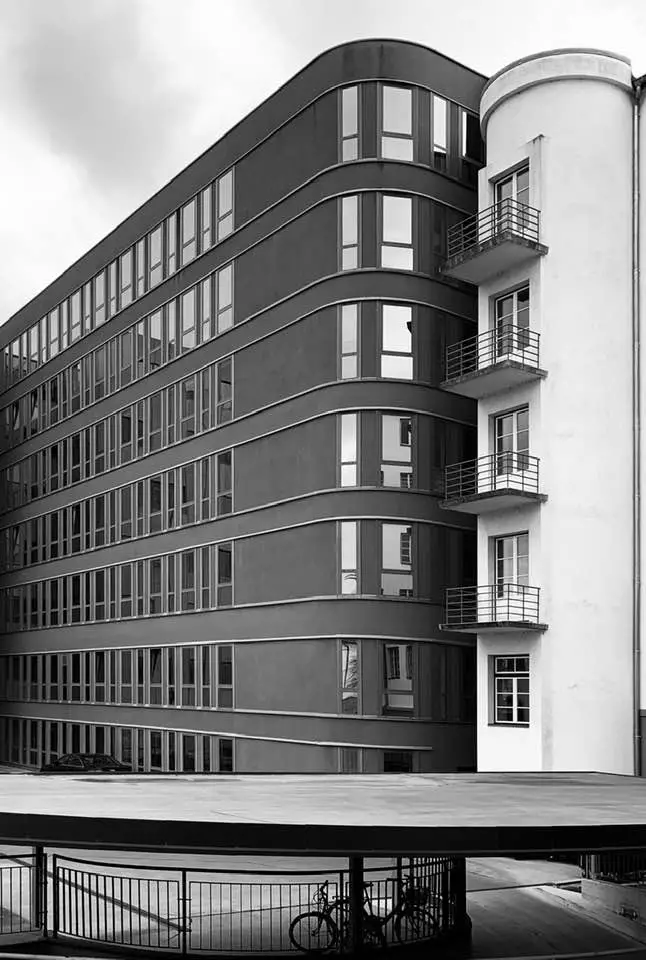
Photo: Igor Andjelič. See more of his work here
Things to do with children
You can find our Top 12 list of things to do with kids in Ljubljana here. If want to read more about the philosophy behind the wonderful House of Experiments look here, while our trip to the Museum of Illusions is documented here, and there’s always riverside walks, pizza and ice cream. With regard to the latter, take a look at our guide to six places that serve good ice cream in winter, and thus are serious about the dessert.
Mini Teater Ljubljana – The season sees a lot of puppet performances for children, in Slovene, at this theatre not far from Križanke. The English schedule for the month is here.
Ljubljana Puppet Theatre - The puppet theatre near the Central Market and next to the Castle funicular has a full programme or shows, for children and adults, with the schedule here.
Vice meets Žižek in Ljubljana. If you want to see more of the most successful writer who lives in Ljubljana, click here
LGBT+ Ljubljana
If you're looking for more general links on "gay Slovenia", including a history of the scene and various projects, then you can find that here, while our stories about the community can be found here.
Klub Monokel – This lesbian bar in Metelkova is open every Friday, although sometimes there are other events
Klub Tiffany –And the gay bar next door is also open on Fridays. Other things coulds also be planned, so click on the name to find out.
Pritličje – This seems to be the only "always open" LGBT-friendly cafe / bar / events space in town, and perhaps the country, so it's a good thing it's such a good one, open from morning to night, and with fliers and posters letting you know what's happening outside the narrow confines of, say, a general interest online what's on... guide.
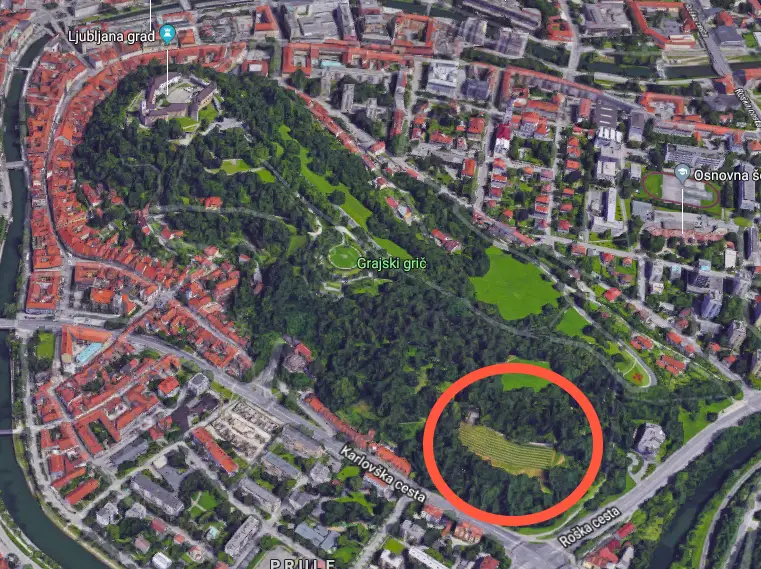
Screenshot from Google Maps, showing the location of the Castle vineyard
Ljubljana Castle
The city’s main attraction is said to be the top tourist draw in the country overall, and to my mind it earns a spot near the top just for the history and views. But beyond that the current owners, the City of Ljubljana, have laid out a varied, interesting and enjoyable programme of events, one that rewards regular revisits. On until 17 November Mighty Guardians of the Past: Castles in the Slovenian Lands, a presentation that delivers on the promise of its title.
I try and get up there every Saturday morning to clear my head and move my feet on the trails, and never tire of that end of the hill. At the other end, where the Castle sits, there’s a lot more than fresh air on offer. There are guided tours, restaurants, a café, Castle museum, puppet museum, a Watchtower you can climb to the highest point in the city, art shows, dances, live music, movies under the stars, festival days and more – enough to reward multiple trips up the hill through the year. All of these activities and events can be found on the Castle website, while on TSN you can see “25 things to know about Ljubljana Castle” here, and “Ten Ways to Enjoy Ljubljana Castle” here.
Museums and galleries
Most public galleries and museums are closed on Mondays, although not the National Museum.
Looking to buy some high end, big name local art from a trusted gallery? Check out our look at Sloart.
Cankerjev dom – On until 3 March 2020 there's an exhibition on Ancient Greek Science and Technology. Details here.
Plečnik's desk. Photo: JL Flanner
Plečnik’s House is worth a visit if you want to learn more about the architect who gave Ljubljana much of its character, and it's also in a really nice part of town, Trnovo, just a short walk or cycle upriver. Read about our guided tour here.
Balassi Institute – The Hungarian culture centre is next to a Spar and Hofer, and not far from Dragon Bridge, and always has something interesting going on. Learn more here.
City Museum – The Museum in French Revolution Square an interesting permanent exhibition on the history of Ljubljana, from prehistoric times to the present day, with many artefacts, models and so on that bring the story alive.You can read about my visit here. On until 25 September is Treasures from Russian Museums, an exhibition showcasing more than 80 Russian icons from leading Russian museums. Also on until 15 September can see the results of the archaeological research of Gosposvetska cesta, Slovenska cesta, Prešernova cesta, Erjavčeva cesta, Tribuna, Križanke, Dalmatinova ulica, Vegova ulica (KGBL) and the area of the University of Ljubljana. Especially interesting for those who know the city.
The Faces of Ljubljana in the City Museum. Photo: JL Flanner
International Centre of Graphic Art – The 33rd Biennial of Graphic Arts runs until 29 September. It's called Crack Up – Crack Down, and is curated by the collective Slavs and Tartars, with a focus satire and the graphic arts. Learn more here.
Jakopič Gallery – Until 29 September you can see the photographs of Lucien Hervé in a show called Geometry of Light
Kapelica Gallery, Kersnikova 4 – In the same building as Klub K4 you can enjoy Earth Without Humans: 'On The Boundaries Of Artificial Life' until August 23, described as follows: “We have started trusting high-tech more than we trust our close friends and family and an increasing number of technology manufacturers are becoming aware of this. The applications that they are developing are becoming increasingly smart and cooperative, while also becoming increasingly aesthetically neutral and humanised.”
Ljubljana Castle on until 17 November Mighty Guardians of the Past: Castles in the Slovenian Lands, a presentation that delivers on the promise of its title. There's also the Parallel Worlds of Alan Hranitelj runs on until September 8, showing the work of the acclaimed costume designer. Until 15 September you can see Jelka Reichman’s illustrations from the picture book Twelve Elephants, written by Leopold Suhodolčan (free admission).
MAO – The Museum of Architecture and Design has much of what you'd expect, along with some temporary shows and a good cafe. On until 19 September is a show called Creators, on contemporary Slovenian fashion and textile design, which is being promoted with the following image.
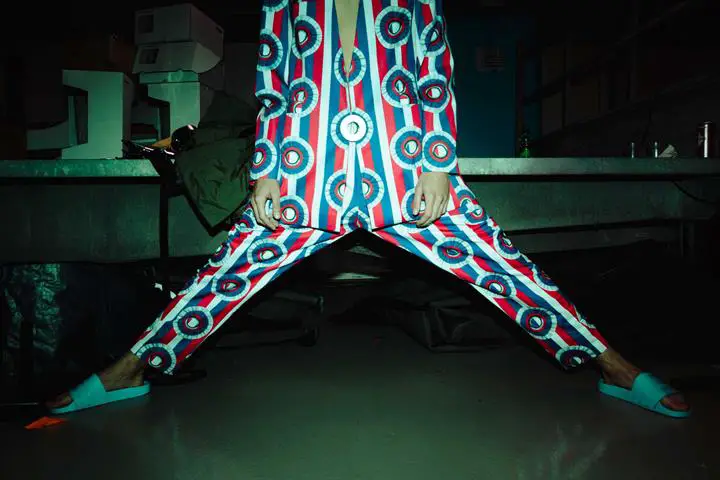
Photo: Urša Premik
Moderna galerija – The main branch of this gallery, to be found near the entrance to Tivoli Park, has a good collection of modern art, as well a nice café in the basement. Opening Thursday, April 25th, 20:00, The Visual Arts in the Kingdom of Yugoslavia, 1929–1941, which then runs until September 15th 2019. This offers “an overview of painting, sculpture, printmaking, drawing, photography, and film from the time the king's dictatorship was set up (6 January 1929) to the beginning of World War II on Yugoslav soil (April 1941)” - you can read more about it here. The museum's Metelkova branch also has a big new show, runing until at least September 2019, an the art of the Non-Aligned Movement, with an example shown below. Until September 15 you can also enjoy Maja Hodošček, a video artist you “explores social relations through the politics of exchange and collaboration; in particular, she is interested in speculative models of representation in relation to the documentary.”
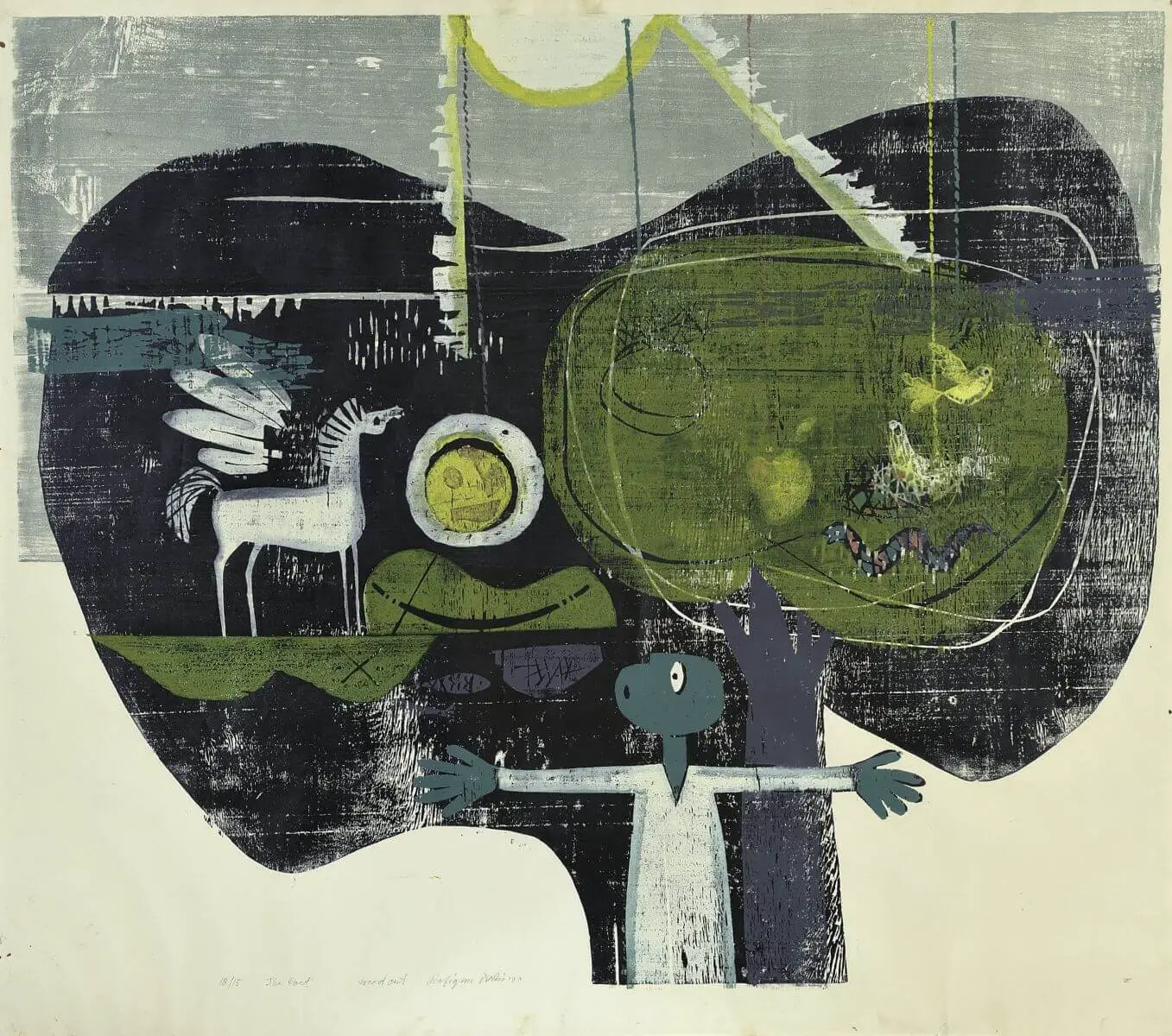
Rafikun Nabi: Poet, 1980, print, 96.5 x 110 cm. Courtesy of the Contemporary Art Center of Montenegro. On display at the Metelova branch of the Moderna galerija
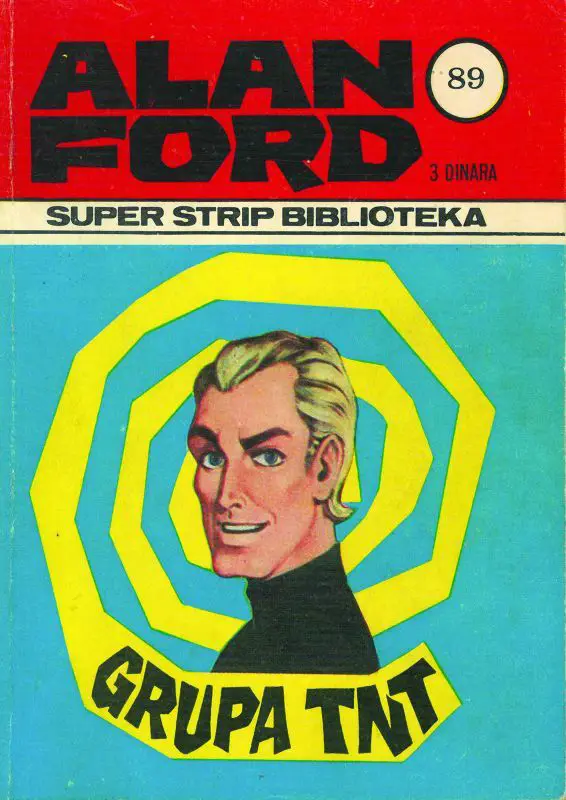
Alan Ford at the National Gallery
National Gallery – The country’s main gallery has “the best” of what’s on offer from the Middle Ages to non-contemporary modern visual arts, and is in a great location for exploring other areas, just by Tivoli Park and opposite the main branch of the Moderna galerija. You can read about our visit to the room containing sacred art from the Middle Ages here. The Space Within the Space: Scenography in Slovenia before 1991 will provide a comprehensive historic, stylistic, visual and theatrical overview of Slovenian scenography until 8 September. There’s also a big show on Alan Ford, one of the great comic books of the Yugoslav era, on until 13 October.
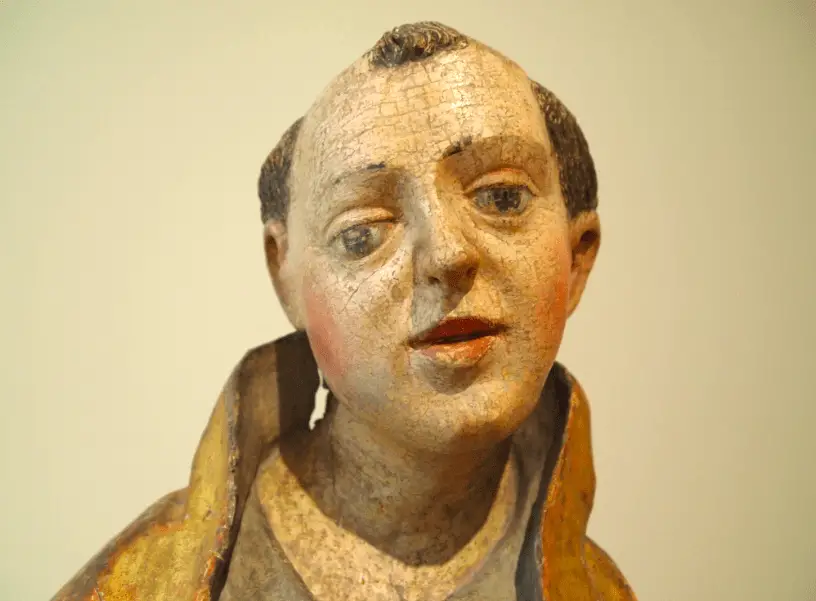
JL Flanner
The real Robba Fountain can be found in the entrance to the National Gallery - the one you see in the Old Town is a genuine fake, as seen below and reported here.
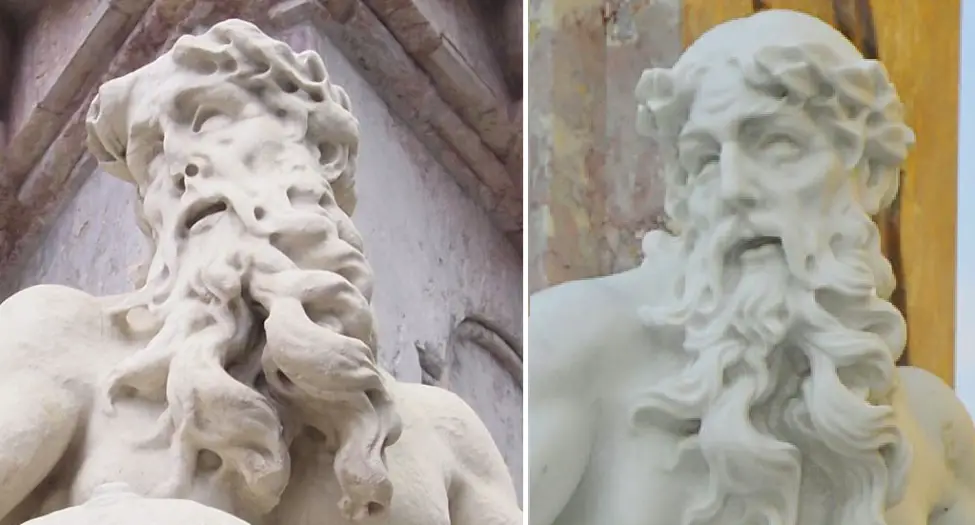
Photo: JL Flanner
National Museum of Slovenia – There’s plenty to see in the permanent collection here, from Roman times, Egypt and more. Running until 3 November is Roma Aeterna: Masterpieces of Classical Sculpture. With sculptures from the collection of the Santarelli family in Rome, ranging from the age of the Roman Empire to that of neoclassicism. Meanwhile, the museum's Metelkova branch, located between one branch of the Moderna galerija and the Ethnographic Museum has some rooms on Church art, furniture and weapons, with the latter including more guns than you'll see anywhere else in town, and quite a thrill if coming from a nation where such objects are not household items.
Natural History Museum – On until the end of December 2019 is Our Little Big Sea, which takes a look at the oceans.
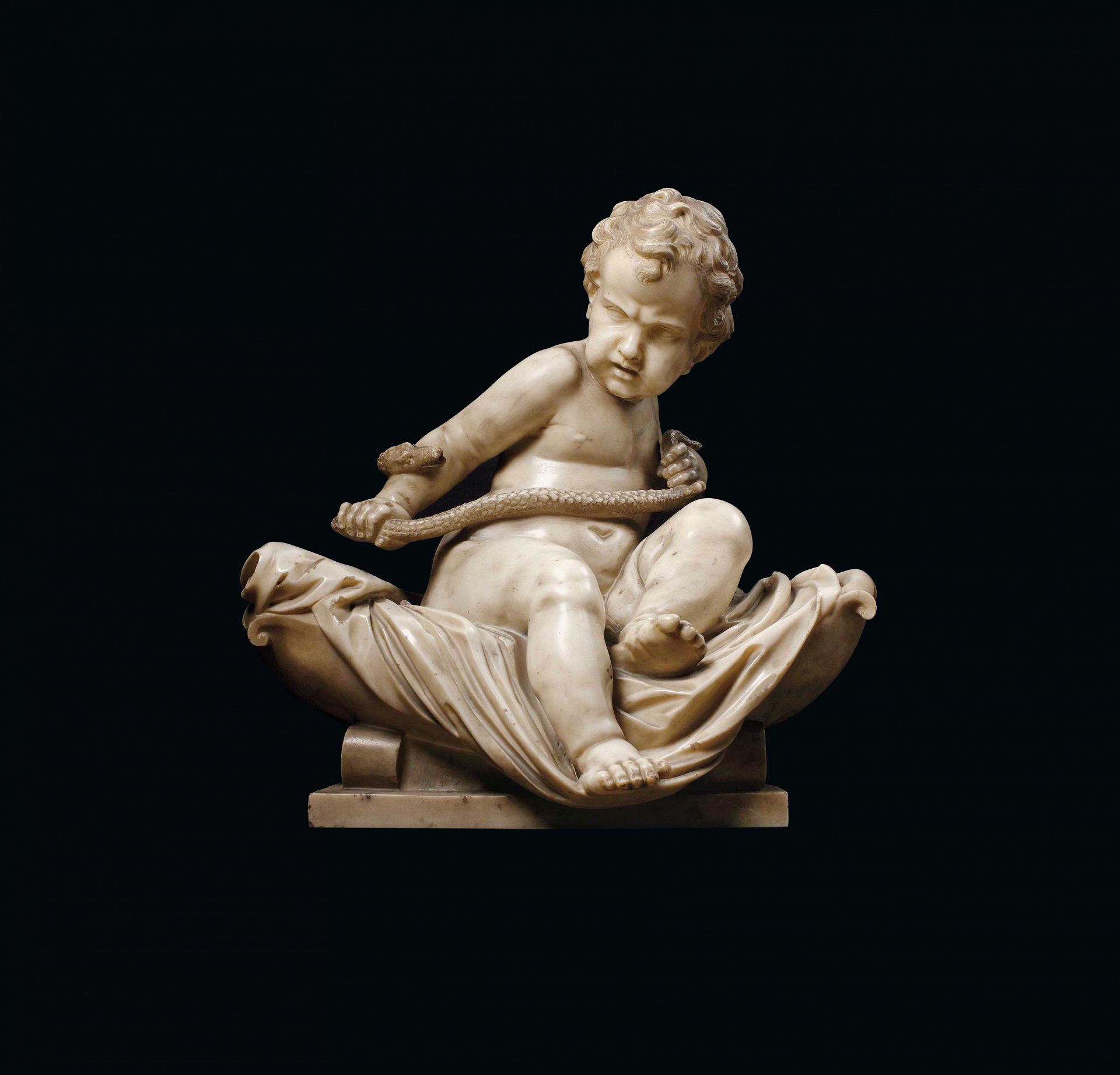
Roma Aeterna: Masterpieces of Classical Sculpture - see below
National Museum of Contemporary History - Tucked away in park Tivoli, in addition to his permanent collection will be showingIn Search Of Freedom: 1968-2018 until 16 August. Until 29 September there also a retrospective on the photographer Edi Šelhaus, which is being promoted with the following image. On until 18 August is Walls, described as follows: “Thirty years after the fall of the Berlin Wall, it is clear that the processes of democratisation and integration of Europe, announced in the historical year of 1989, have failed to achieve their goals. Although many real and symbolic walls have been demolished, new ones have been raised instead, and some still deeply disturbed our society.”
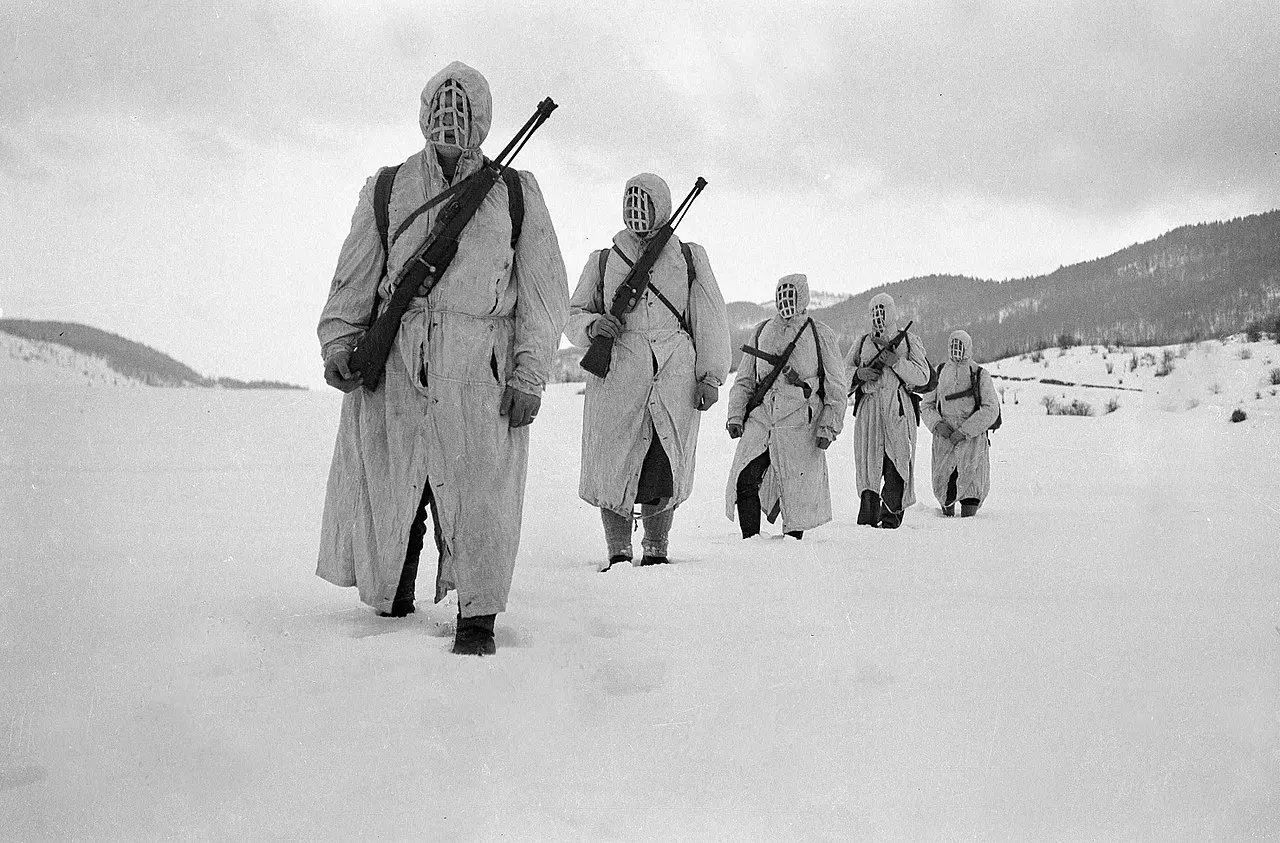
Photo: Edi Šelhaus
Slovene Ethnographic Museum – The museum has two permanent exhibitions. One of these is called Between Nature and Culture, and has a great collection of objects from Slovenia and around the world, well worth the trip up to the third floor to see it (as recounted here). From April 18 until October 19 (2019) you can also see a show calledShamanism of the Peoples of Siberia, from the Russian Museum of Ethnography, Saint Petersburg. The place is located near the newer branch of the Moderna galerija and Metelkova. You can read about this fascinating show here. On until September 15 is Petra Šink: The circle between design and nature, in which the award-winning designer takes visitors through the life cycle of useful products for the home which are made from natural biodegradable fungal materials.
Town Hall – On until 22 August there’s a show from Miha Štrukelj with paintings of cities in Taiwan and China, called Alter Ego of Cities.
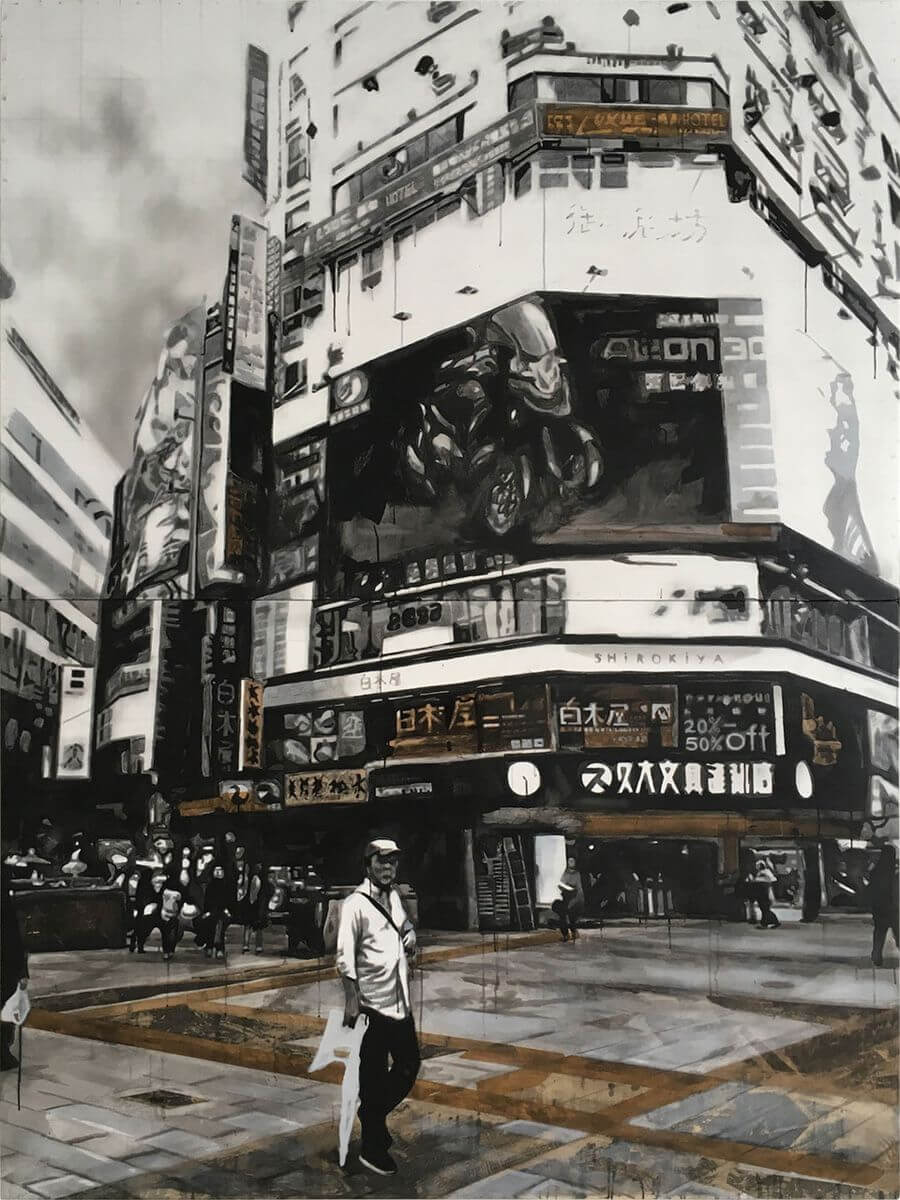
Miha Štrukelj, Shopping District, 2016, acrylic, ink, charcoal, pencil, crêpe paper on canvas, 300 x 225 cm
Union is "the Ljubljana beer", but now both it and Laško are owned by Heineken. There are many local brews on offer around town, though, if you want to explore IPAs, stouts, wheatbeers, sours and so on Photo: JL Flanner
Union Experience – The Ljubljana-based brewer has a museum showing the history of the company, with the ticket also including access to part of the factory and a few samples of the product. You can read about our visit here.
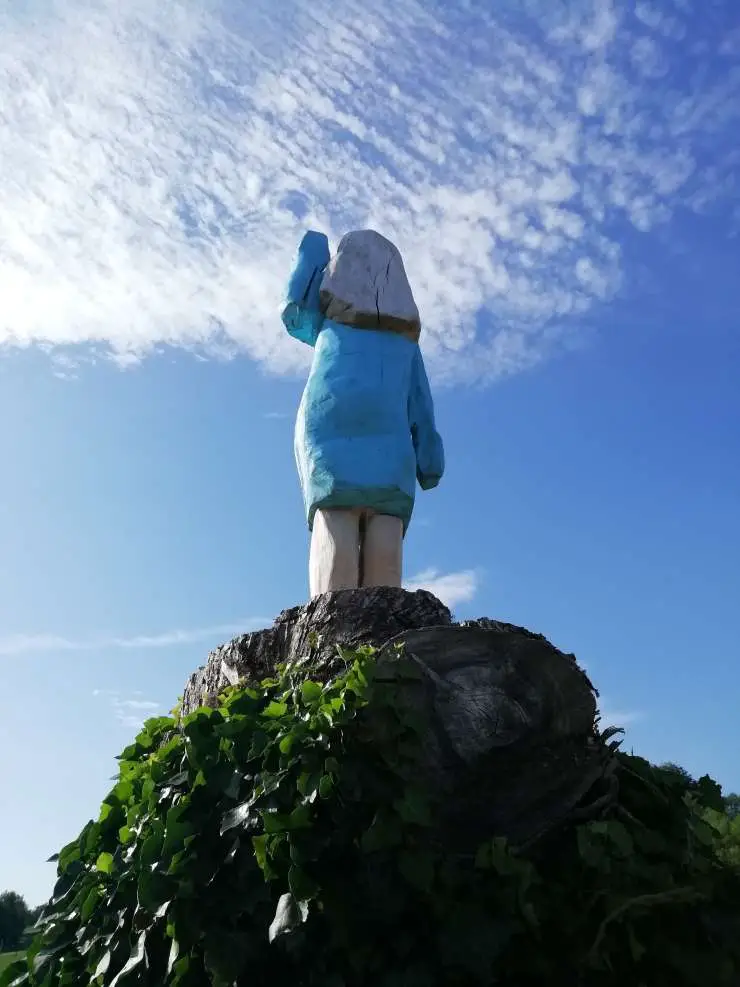
Vžigalica Gallery – If you’re curious about the man who commissioned that Melania Trump sculpture, then you can see more of activities here, in a show called Brad Downey: This Echo.
Volčji Potok Arboretum - Running until 3 November you can see a large collection of cacti here.
It's not a formal museum, but if you're interested in "Yugo-stalgia" then you'll enjoy a trip to Verba, a small, privately run space that's crammed with objects and pop culture items from the era, and is conveniently located at the start of one of the short walks to the castle. It's also a great place to take pictures, if you leave a donation, and you can read more about it here.
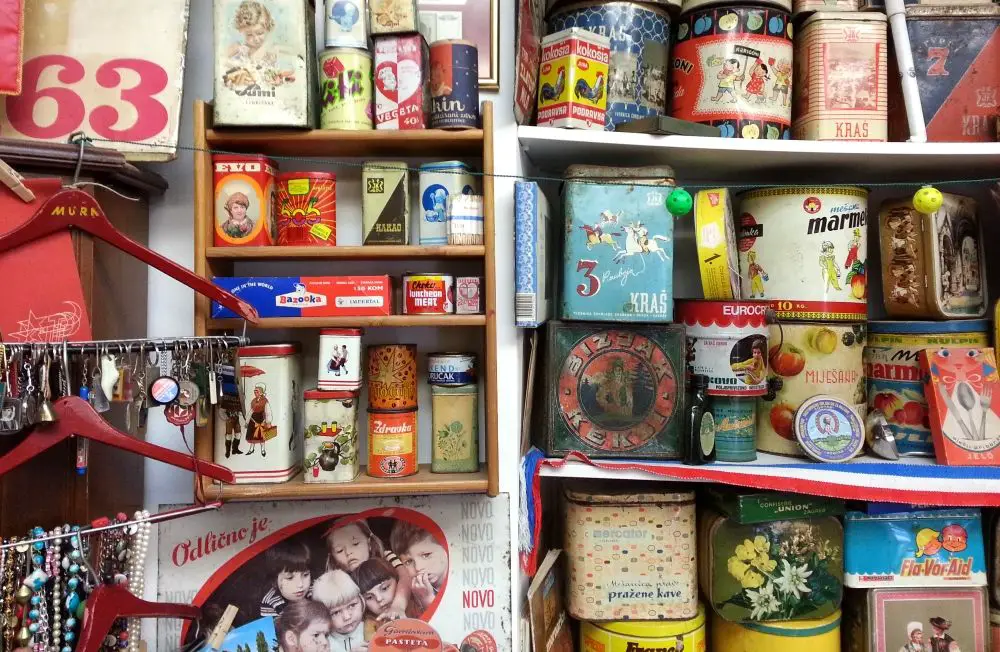
Verba. Photo: JL Flanner
Alternative Ljubljana isn't a museum or gallery, as such, but instead turns the city streets into a museum and gallery. Learn more about their tours of street art, history and LGBT Ljubljana here.
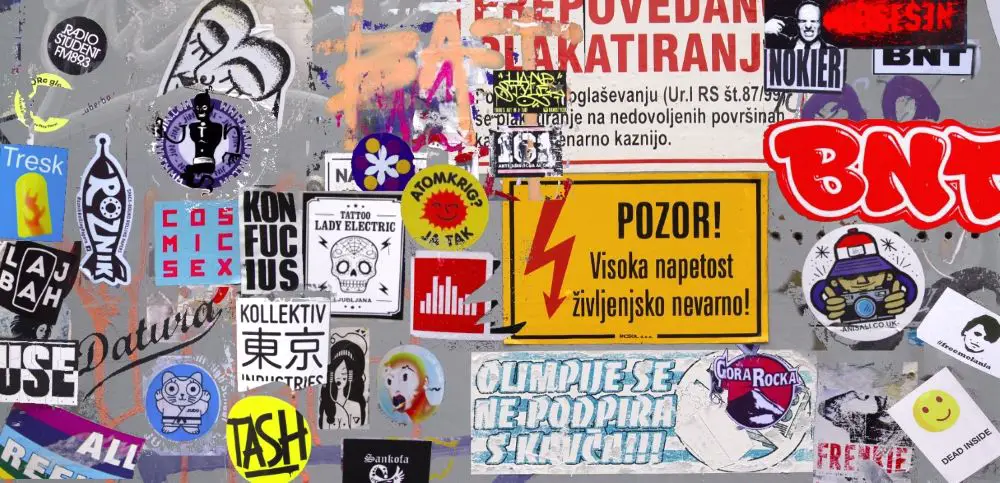
Photo: JL Flanner
Other things to do in Ljubljana
Learn more about Ljubljana with "25 things to know about Slovenia's green city of dragons", or take a look at our guide to spending from four to 48 hours here.
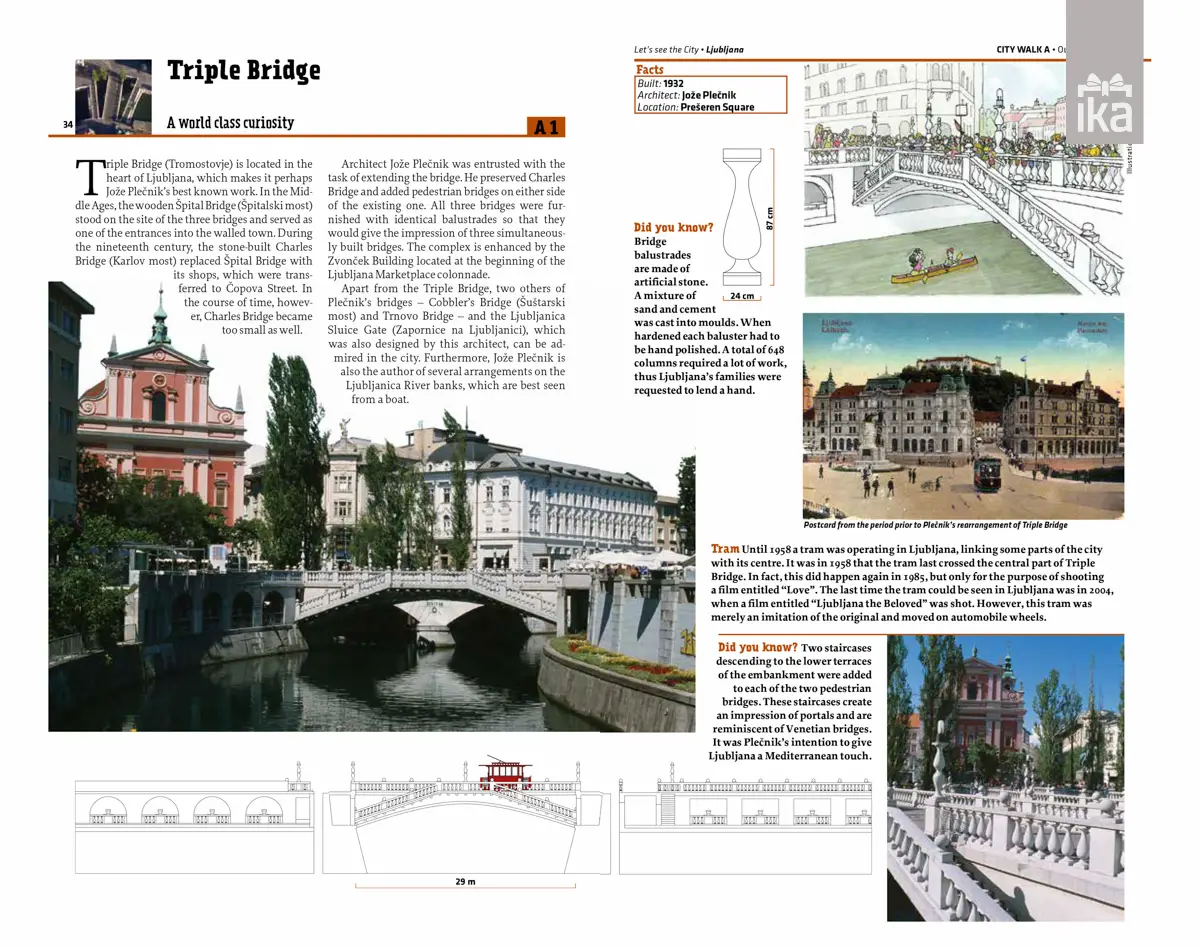
If you like the city's architecture then check out this great book, Let’s See the City - Ljubljana: Architectural Walks & Tours, with our review here and a page from the book shown above. We took a walk with one of the authors who showed us how much there is to learn and enjoy if you slow down and pay attention - read about that here.
Open Kitchen brings market stalls selling food and drink from some of the best restaurants in town every Friday, from 11am to 11pm, in the square between the cathedral and the river - just follow your nose and the crowds. Read more about it here.
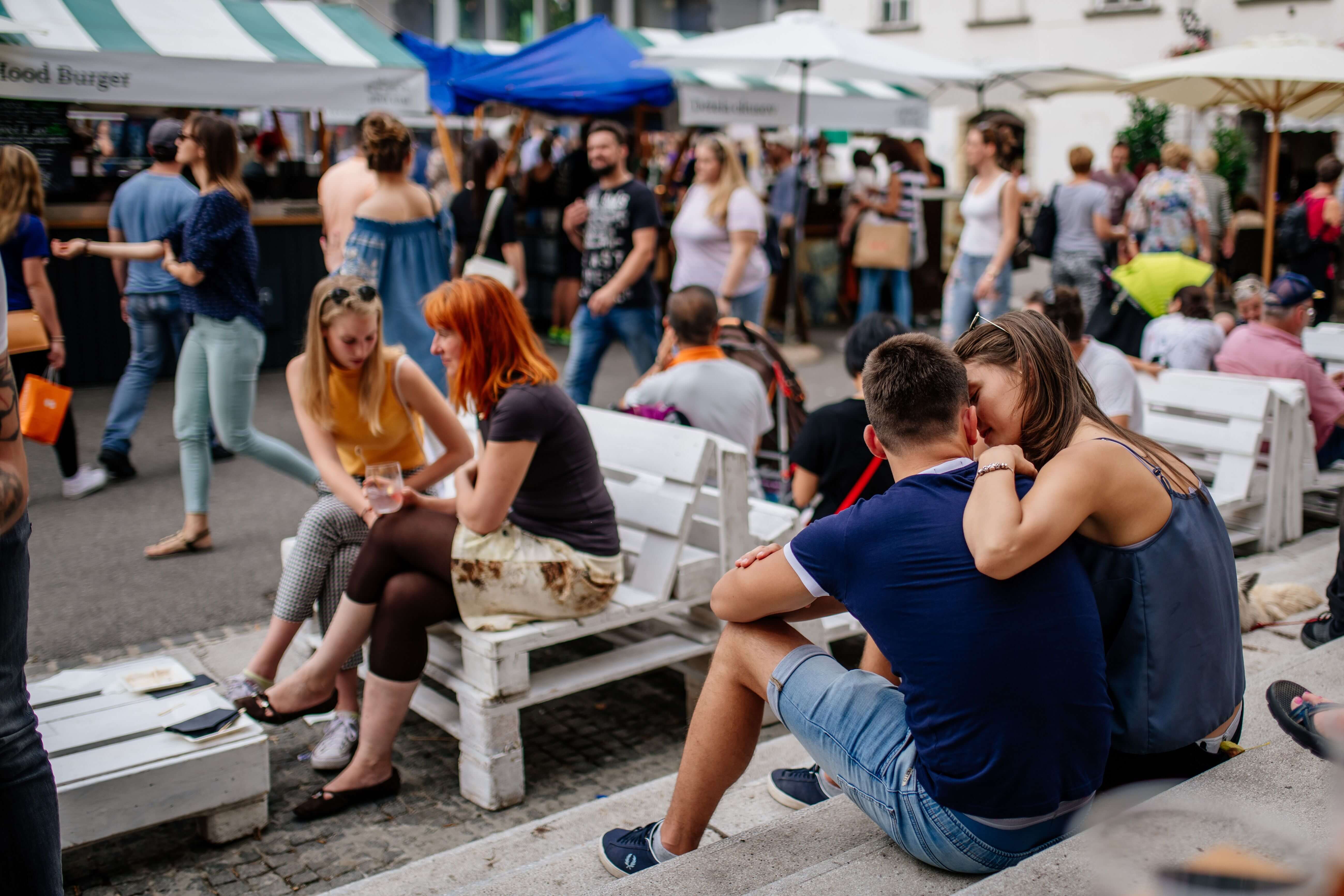
Photo: Open Kitchen
Ljubljana has some beautiful buildings from the early 20th century, in the Secessionist style, like the one below. Learn where to find them here.
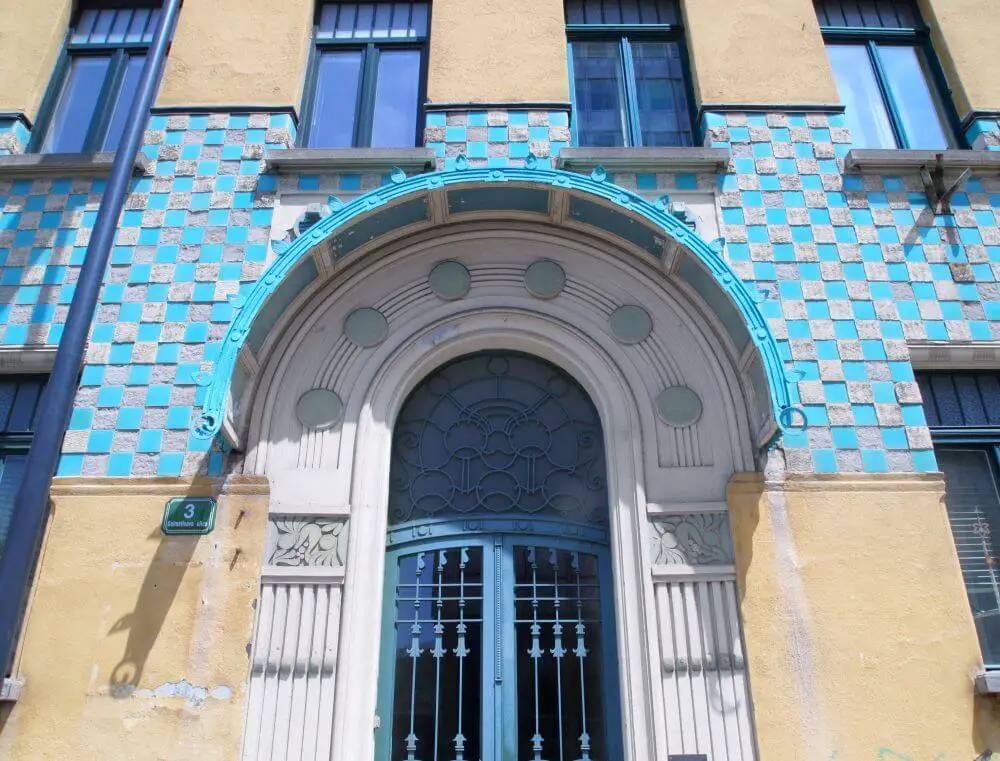
Photo: Neža Loštrek
For something a little more brual, check out Republika trg / Republic Square, in the heart of the political quarter.
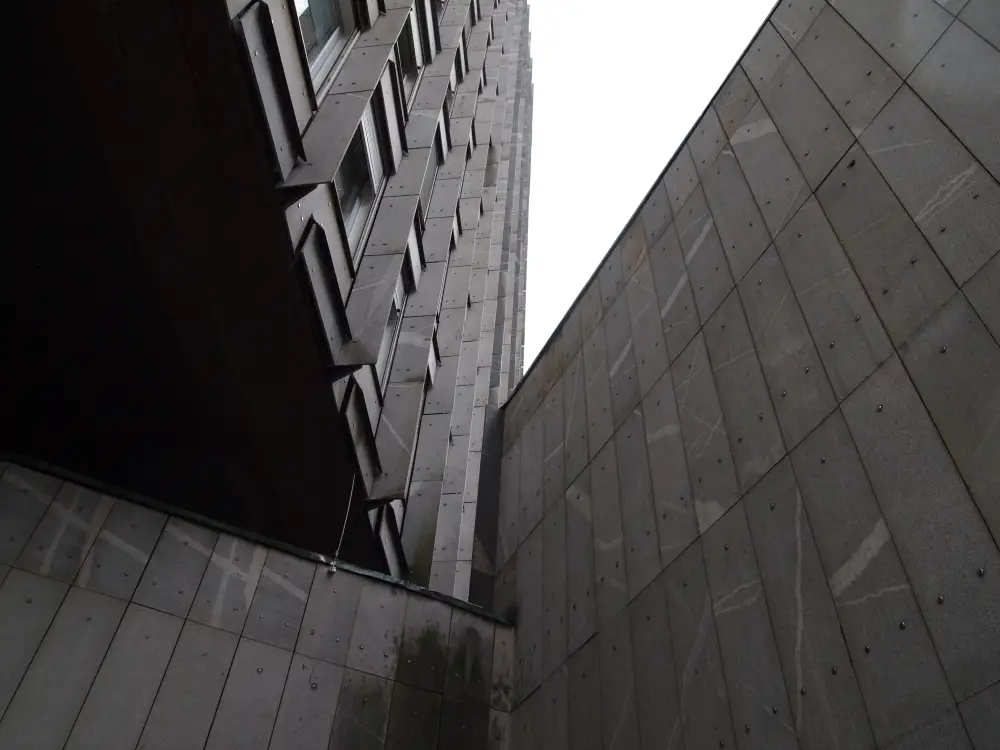
Photo: JL Flanner
Photo: JL Flanner
Some view of the city you can only get from the river. If you'd like to take a boat ride then read about my experience here. If you prefer to get in the water rather than on it, then here's a guide to the various open air pools in Ljubljana. Note that it was written last year and so the prices and times may have changed, so do click the links and check.
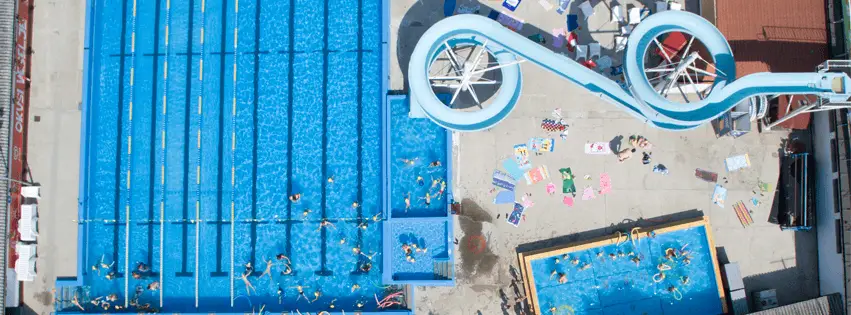
If you'd like to spend an evening painting with others, then take a look at Design with Wine, which organises painting parties on Trubarjeva cesta,
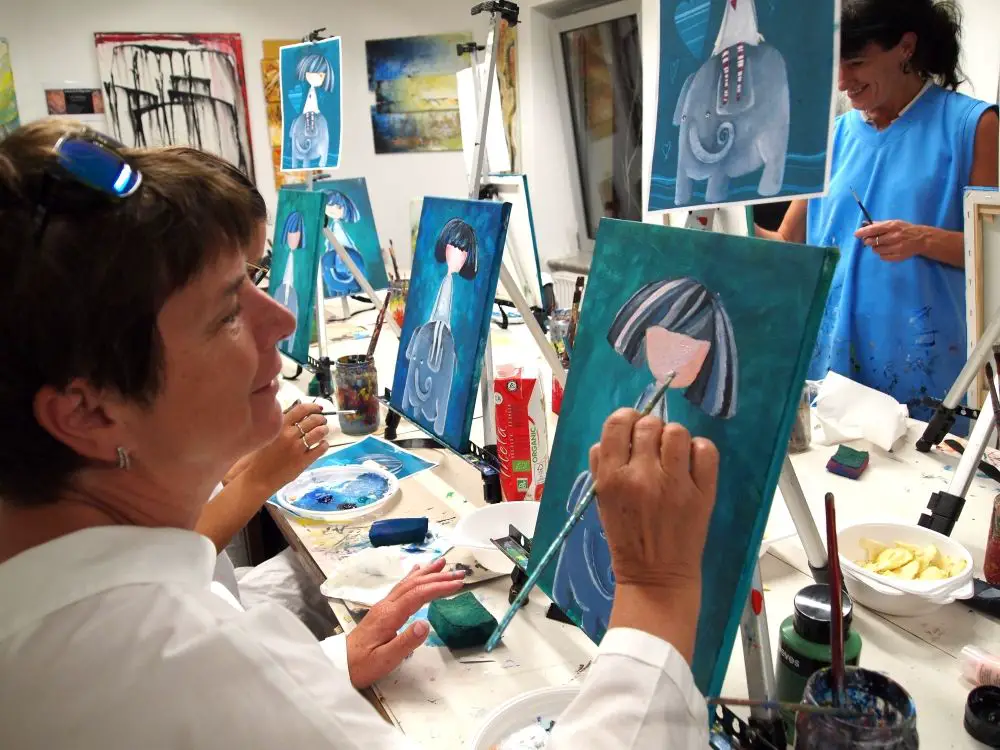
If you want to see some antiques, then check out the wonderful Antika Carniola, as discussed here. The man behind it, Jaka Prijatelj, has a fine eye for life on this street, as you can see on his Facebook account.
Photo: JL Flanner
If you’re in town and want to go jogging or walking in nature, why not take another look at the Castle, with a brief guide to the trails here. If you want something bigger, head to Tivoli Park.
And if you're bored with the Old Town, why not take a walk, cycle or boat ride to nearby Špica and enjoy the riverside life. Learn more about that here.
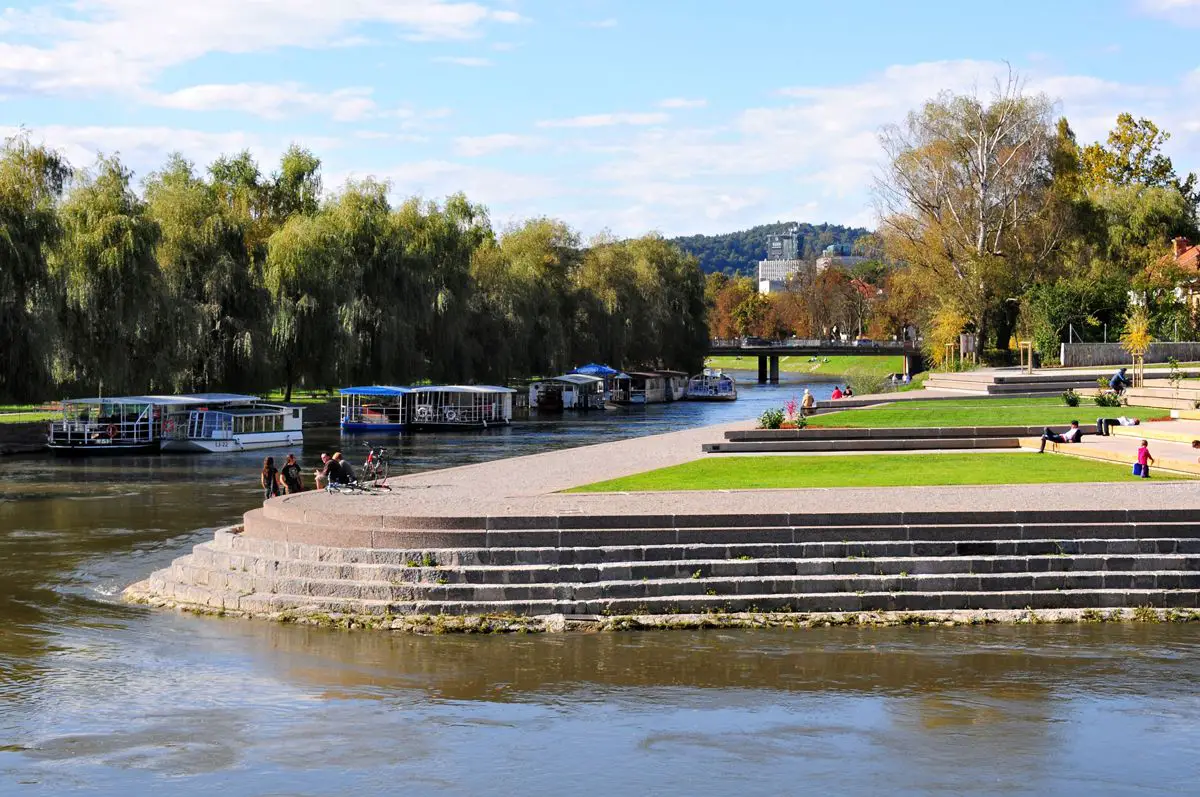
visitljubjana.si
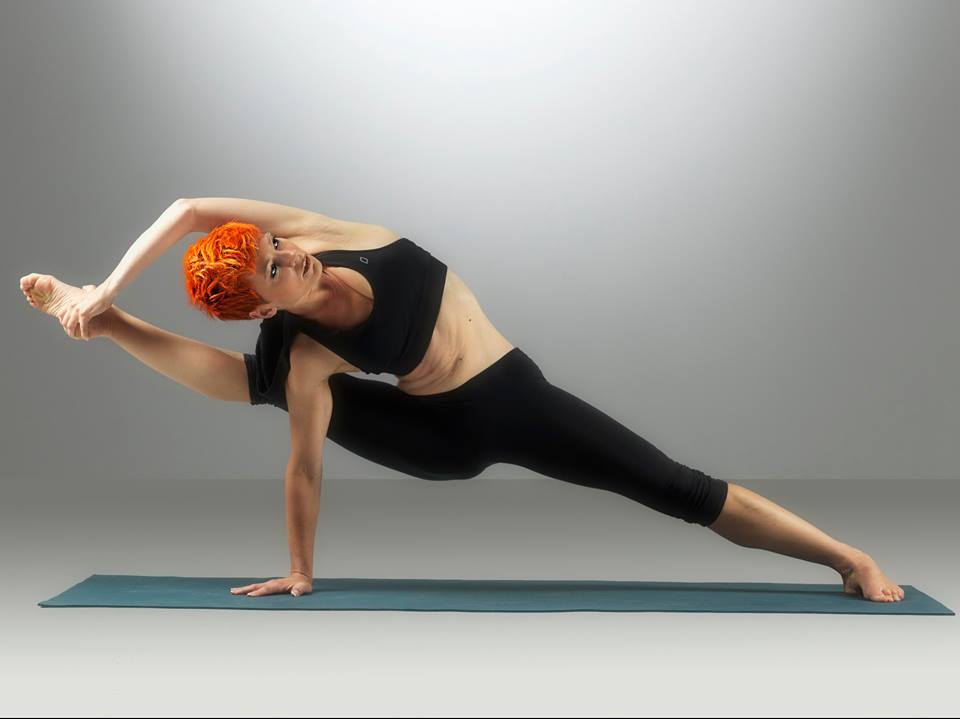
Want to stretch and breath? Then check out our list of drop-in yoga classes for tourists, visitors and the uncommitted. We go to Nataraja Studio, by Dragon Bridge, and here's a story about it.
Prefer to have someone else stretch you? The check out the totally legit massages you can get from Sense Wellness - either in one of their spas or in you home, office or hotel. (And - to repeat - these are legit and non-sexual in nature)
There are some golf courses near Ljubljana, but even ones further away are not far, as seen in our list of all the golf courses in Slovenia.
![]()
Photo: maxpixel.net, public domain
Daytrips
Most of Slovenia is only a few hours from Ljubljana, and you can easily visit Lake Bled, Lipica Stud Farm, Postojna Cave, Predjama Castle, the coast and other locations, while if you'd like to take a photo of from that bench in Bled, then you can learn how to get there here. If you’re looking for something more ambitious, then check out our recent guide to the 17 members of the Association of Historical Towns of Slovenia. We've also written guides on spending from four to 48 hours in Bled and Piran.
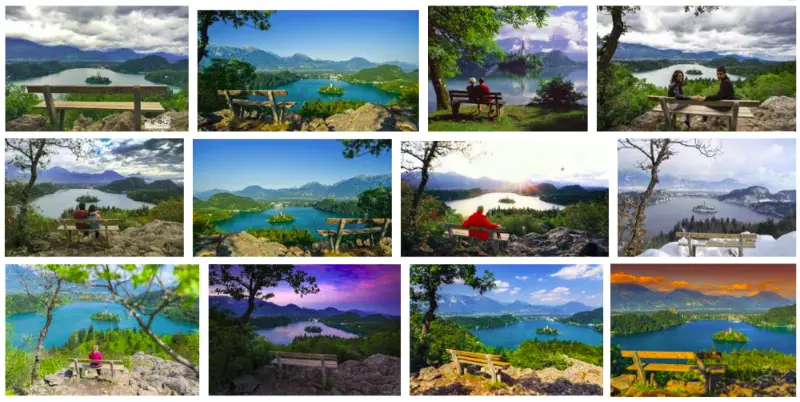
Photo: Google Image Search
Getting around
If you want to get a Ljubljana Tourist Card, which gives you travel on the city buses and entry to a lot of attractions, then you can read more about that here, and if you want to use the bike share system, as useful for visitors as it is for residents, then you can learn more by clicking this. Visitors with reduced mobility will be pleased to find that downtown Ljubljana is generally rated as good with regard to accessibility, and that there’s a free, city-sponsored app called Ljubljana by Wheelchair highlighting cafés, attractions and so on with ramps, disabled bathrooms and Eurokey facilities, which you can read about and download here. Manual wheelchair users can also borrow, for free, an attachment that will motorise their equipment, as reported here.
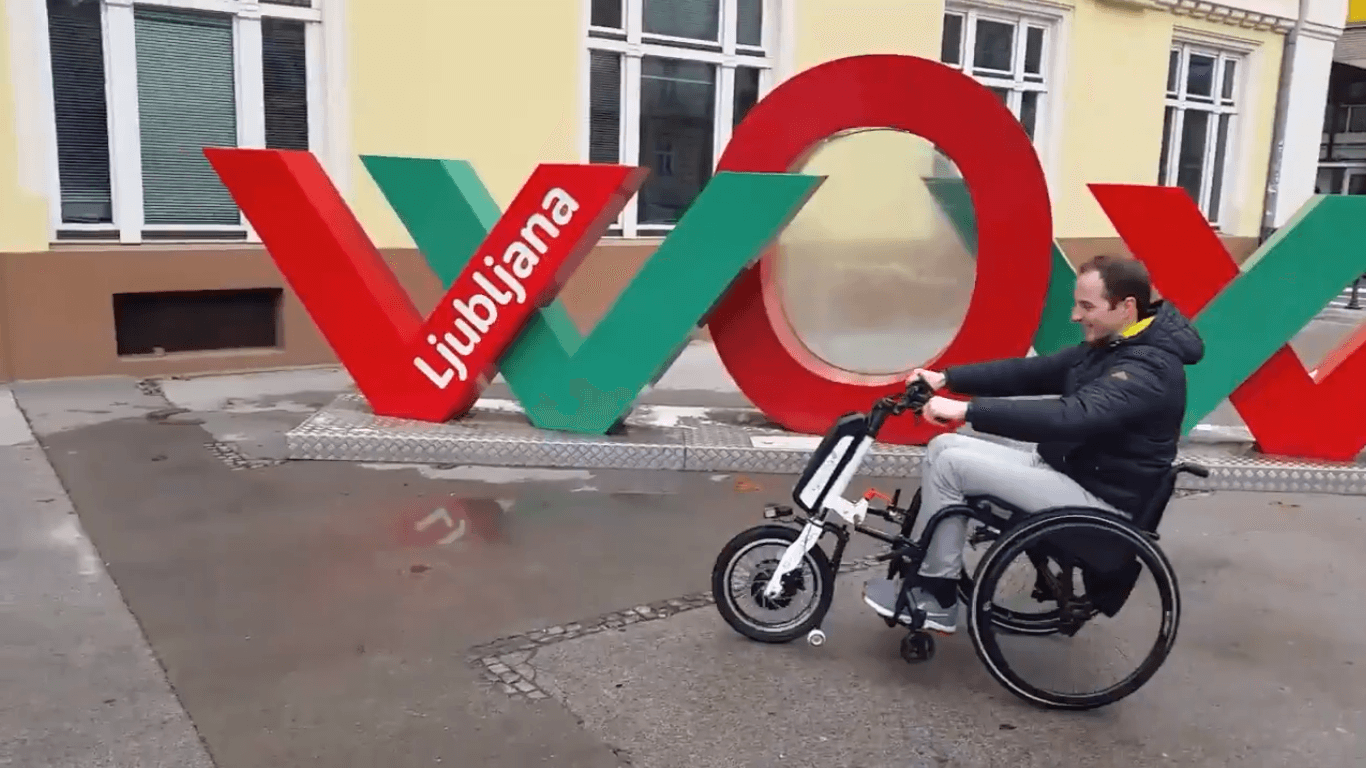
Screenshot from a Twitter video
If you’re driving into town and don’t know where to park, our guide to how to park in Ljubljana is here.
Emergencies
Ljubljana is a small and relatively safe city, but if need to contact the police then there’s a special number for foreigners, and that’s 113.
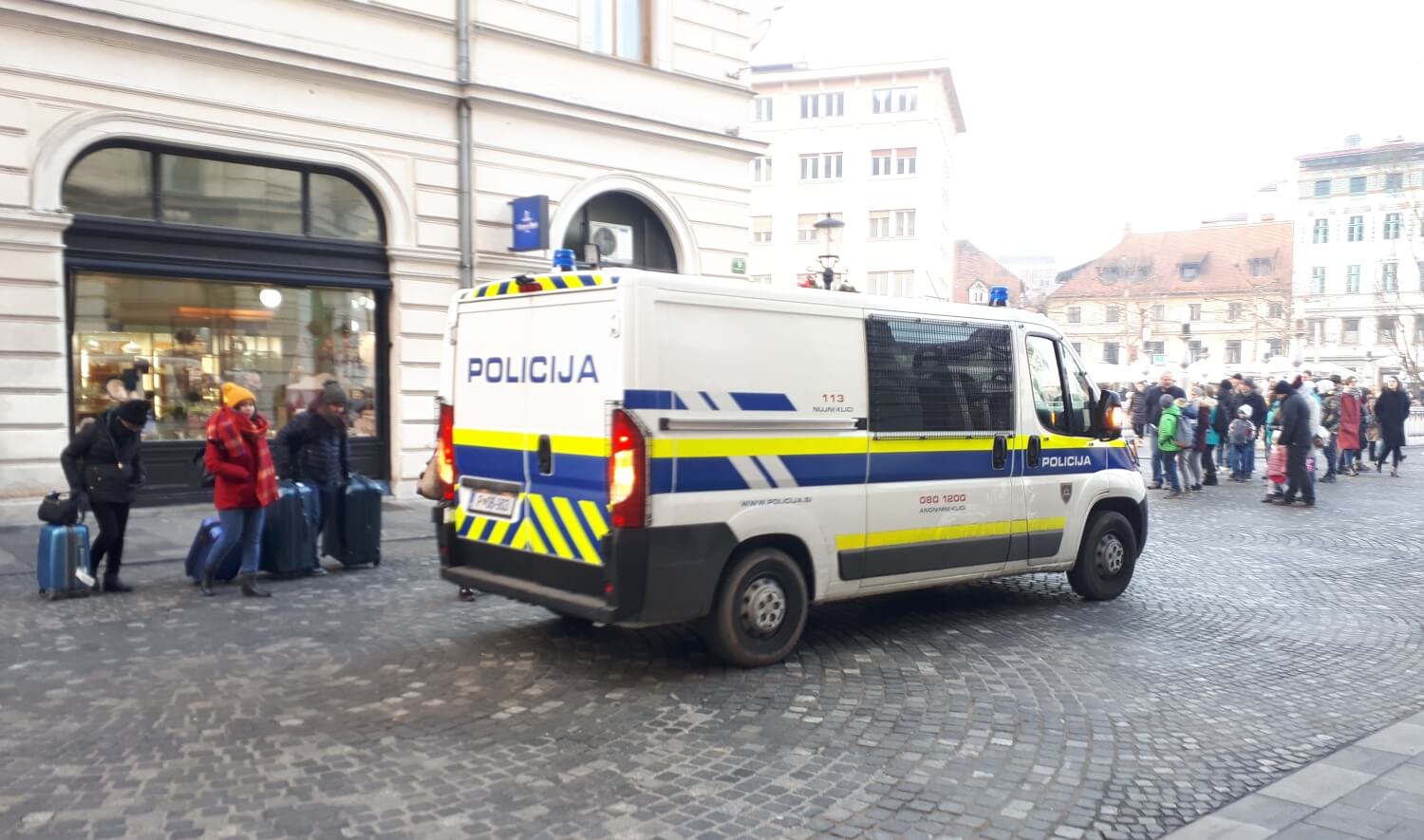
Photo: JL Flanner
There aren't many places to eat after midnight, and most of them are by the train station, as reported here.
Want / need cigarettes but the stores have closed? Here's an incomplete list of bars downtown that will satisfy your craving for the demon weed. While if you’re having trouble with the ATMs then here’s a guide to the Slovene you’ll see on screen. If you get a hangover then find out where to get paracetamol (and prescription drugs) in Ljubljana here, while details on emergency birth control can be found here.
STA, 10 August 2019 - Farmers demanded a significant decrease in the country's wolf population at a rally in Velike Lašče on Saturday. They believe wolf population must be restricted to a fenced-in reserve in state-owned forests and demand preferential treatment for people living in wolf-populated areas.
Addressing the rally this morning, president of the Farmers' Trade Union Anton Medved said that the union would not agree to having to fence in the entire countryside.
"Just like farmers are obligated to prevent our animals from causing damage to neighbours, the state is obligated to take care of its wild animals, so that they will not cause damage to Slovenian farmers, said the president of the union that organised the rally.
He also said it was unacceptable that the wolf population had spread into the Alps, where a number attacks have been reported this year.
A banner spanning over the stage showed the map of Slovenia with dozens of red dots indicating the locations of attacks that happened in the past six months.
While most of the attacks happened in the southern regions of Dolenjska and Notranjska, the map also showed about a dozen attacks in the Alps of the northwestern region of Gorenjska.
Moreover, Medved demanded that the the state should recognise a lower standard of living for people living in areas with wild animal population, thus introducing tax relieves and development incentives to their benefit.
He also called on Environment and Spatial Planning Minister Simon Zajc to resign. The minister meanwhile responded by saying that the call for resignation was unfounded.
He said in a written statement that he was completely aware of the seriousness of the situation and that he expects those charged with implementing the recently passed intervention law, ordering the kill of 11 wolves, to come up with solutions to do this faster.
Medved said in his speech thta "the Farmers' Trade Union will do everything it can for the Slovenian countryside to remain cultivated, inhabited and to become safe again".
"Only this way will it be attractive for the young... and only this way will Slovenia be able to produce sufficient amounts of food to sustain it through any form of emergency situations."
Until their demands are met, the union is set on staging rallies every weekend. In a week, they will protest in Ilirska Bistrica and a week later in Gornja Radgona, where the country's biggest agricultural and food fair, AGRA, will be taking place.
The protest was also addressed by Agriculture and Food Minister Aleksandra Pivec, who said that the two relevant ministries, her's and the Environment Ministry, and the entire government were determined to tackle the situation.
She also said that these issues should not become political, but should be left to experts.
The latter, on the other hand, do not enjoy much respect among farmers, who believe that experts are at fault that the wild animal populations have reached such high numbers.
According to estimates, there are some 1,000 bears in Slovenia and nearly 90 wolves, living in 14 packs. Farmers and many hunters also believe that the number of wolves slated to be killed is too low and that the intervention act, which was passed in June summer, was ineffective because it imposed too many conditions.
The number of wolf attacks on farm animals has doubled this year over the same period in 2018. Data from the Institute for Forests show that nearly 680 animals had been attacked by the end of July.
Official data show that wolf attacked nearly 580 sheep and goats, but they also attacked larger animals: 41 horses and 34 bovine, as well as two dogs. By now, the total figure has exceeded 700, as new attacks are reported every few days.
All our stories on wolves in Slovenia are here, while bears in Slovenia are here


